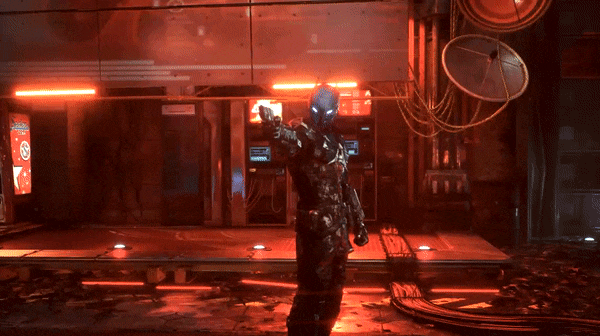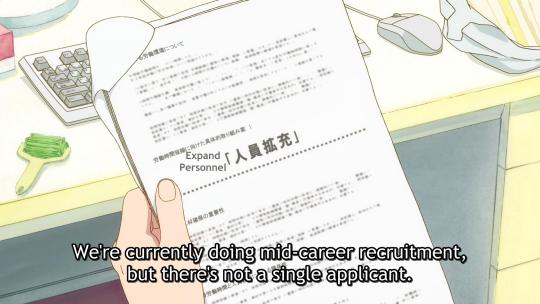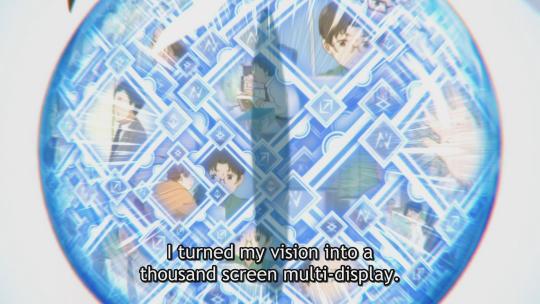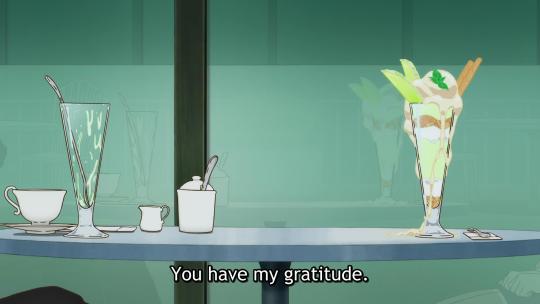#variant split retired!
Explore tagged Tumblr posts
Text
Re-found a doodle I had made of Bloody and Fang together
The expected happened
Tho before that, let’s set the description for Bloody and Fang’s unique designs.
Bloody— he wears the same jacket Harvest and he got from Solar, a sloppily sewn together mix of red and black fabrics and the upper part of their original hoodie; only they have attached several things to the hood, two sets of hair pins right above both of his eyes, the right one in an x shape, the left one a rectangle, to the left side there’s two should-be-fluorescent earrings (that aren’t cuz I didn’t color them), and to the right there’s about three or four pinzas (plastic, small, to attach clothes to the clothing line to dry, I FORGOT THE NAME IN ENGLISH OK?!) attached together forming a small chain. Unlike Harvest or their together appearance, he has the sleeves all the way down, covering their arm warmers— which are mismatched red and black, and quite possibly are filled with holes or something. They wear the same scarf thing Harvest does. His shirt isn’t tucked in, and neither is it solid black but that detail can be ignored. He’s wearing actual shorts that look like shorts on them, presumably the pineapple shorts that had caught their eye in-canon (I am never letting that piece of characterization go). Instead of the boots the Twins would wear together, they have a red and black sneaker on his right foot and a pink and teal croc on his left, and under them he has mismatched socks, right one being a loose fitting purple with stripes, left one being a pink with polka dots one. Yeah their clothing is all over the place. Their appearance is basically the same as Retired’s usual looks, Second Version Bloodmoon, visible “eyebags”, presumably mismatched leg casing, though his right eye lacks the spirals it usually has.
Fang— the only things Fang shares with Swap’s together design and the canon//my interpretation of canon’s design is the color of casing and the hat fluff. Fang doesn’t really wear much clothing, having a hat, a skirt, and arm warmers. The hat is twin tailed much like the usual AI 2 First Version Bloodmoon here, only the colors and patterns differ, the right part of the hat being red with black x’s gradually intensifying towards the hat’s tail, the left part being black with red x’s that basically look the same as previously described. In between the top fluff there are two slightly curved horns. There’s fluff in Fang’s chest as well, covering the shoulders, chest, and upper back, white pentagram pendant lying in between the fluff. The arm warmers are black. The skirt is red and segmented, with usually four— technically five— segments visible at a time, these segments are stitched together by three x like patterns each. The technicality arises by the segment right in what could be considered the front//middle? Of the character, this segment doesn’t have the same x’s the others do and is longer than the others, being black with an inverted cross symbol that is not seen on any of the following drawings sadly. There’s another segment like this parallel to it which is actually longer but it isn’t very relevant here. Fang has animal like legs, specifically those of a cat or dog, the ones that go on a curve and then drop and then there’s the feet, those ones. The legs have fluff in the second joint. Fang also has a tail similar to what is usually drawn for Lunar designs, like a string with a ring at the end and a star, the star is white and the ring is red. Fang has closed eyes for the most part, but the one eye that is shown open twice is the left one which instead of a pentagram pattern has a simple white slit pupil.
Ok that enough yapping, doodle time




And a small comic, featuring Harvest and Scythe



Translation for the Swap Twins:
Scythe: Out here, living my best life
Fang: Harvest is drowning
Scythe: This isn’t about them
#chaos in the house#retired!bloodmoon#swap!bloodmoon#variant split swap!#variant split retired!#budding bonds through worlds#I… have no friendship tag for Bloody and Fang :(#nonverbal buds?#would that work?#bloodmoon sams#sams bloodtwins#tsams bloodtwins
3 notes
·
View notes
Text
i just need you to know that i have had such an intense and constant MCU hyperfixation for my entire life that since around 2015 i have been rewriting the movies in little ways in my head
like each new thing that's come out im like "hmm yes but what if this happened like this instead"
total fanfic vibes, but i've never written any of it down, so my head is full of like a decade of movie rewrites building on each other
so i have my own FOURTH, IMAGINARY group of Avengers going on in my head too,
so to me it's like
Thunderbolts*, Sam's new Avengers, Kamala's in progress Young Avengers, and My Freaks (not an actual name)
i have changed so many things in my head over the years that im basically living in an alternate timeline of movies at this point
and just for fun, My Freaks consist of Bruce, Nat (she is ALIVE to me, i love my girl, my friend, my.....uhhh...mom? sister??), Loki (main MCU timeline who would have died in Infinity War- but like hell i would let her die though- and variants; Kid Loki, Alligator Loki, Boastful, Classic, President, TVA Loki too but he IS still in a tree rn even in my mind fanfic), Milo from Morbius (shut up and let me have this, and once again i refuse to let him die- this is a pattern), Ben Affleck Daredevil, Kitty Bobby John Rogue Wolverine Magneto Professor X Toad Nightcrawler Jean Scott Storm Beast all from the 2000s trilogy, Channing Tatum Gambit, the 2005 Fantastic Four, Tom Hardy Eddie & Venom, the Spot from ATSV, Harley Keener (Ironman 3), Moon Knight, Age of Ultron Pietro (my boy didn't even get to be called Quicksilver, and he was shot to death? not my boy, no he's FASTER than bullets, what the hell happened there, no he's alive actually)
basically everyone who wasn't in a team (Daredevil), were left over from a team who split up or retired (Bruce and Nat), were in the Void (most of the Lokis, also Daredevil, 2000s Xmen, Gambit, Fantastic Four), died (also Nat, quite a few from the 2000s Xmen grouping aswell), or haven't been in much of a big story yet (Harley, Gambit so far, Spot since his story is a 2-parter and BTSV isn't here yet so i yoinked him into MY story)
i built this team in my mind cave, with a box of scraps
really i snatched a lot more of them after Deadpool and Wolverine, like hey, if we have a bunch more people in the Void, people not in mainline MCU, imma take em,
but overall once NWH brought in magic that can connect to other universes i was like ooohhhh yah okay i'll branch off into other movie universes too, grab Milo- i want a giant lizard man AND a vampire please, let's make it WEIRD
like i needed an actual scientific/magical in universe reason to justify why other universes could link together haha- nothing means anything but also everything means everything and my brain is a fun place
i've connected a lot of things in odd ways at this point, like Harry from the Maguire trilogy is dating Harley, Tales of Asgard Loki is friends with TSSM Harry and Xmen Evolution Wanda, Sylvie lives in New Asgard and is neighbors with Thor and Love and sometimes Mobius lives at her place for a while, Maguire trilogy Sandman helps out with Morgan and Love and they have playdates with his daughter Penny, Happy is training venom movie Mulligan (and now his symbiote Toxin) to work security at Stark Industries, Nicolas Cage Johnny Blaze is friends with TSSM Montana and they wear cowboy hats and ride motorcycles together, Kid Loki also helps out with Love and now he gets to be the big brother
and also everyone else i love is alive too :)
and i put other people into other universes too, like Elektra and Daredevil aren't together anymore and she doesn't care about him so he's in the MCU universe, and she's in the Andrew Garfield Spiderman universe because why not- also i put Blade and Ghost Rider there
Marvel should let me make a movie- it'll be weird, kinda fan servicey, kind of mentally ill, but very intricate and loving
i am completely insane :)
i've put the MCU, the xmen, the spiderverse, Venom trilogy, and many others in a blender and made an unsettling smoothy
8 notes
·
View notes
Text
⋆˙꒰ SUKI'S ORIGINAL CHARACTERZ .ᐟ ꒱ prior to delving into my ocs, please acknowledge that every character that is presented on my profile are exclusively and personally owned by me. i have placed blood, sweat and tears into these characters, as well as their whole being + making. please do not plagarize + steal my layout, nor my characters.
☆ !? xoxo, yours truly !? ⋆




⋆˙kaito malikai jackson .ᐟᝰ

꩜ names + etymology. the name kaito has japanese origins. in japanese, if you split kaito's name in half, kai means "sea", and to means "fly", so all of it put together, his name can be interpreted ti mean "flying across the ocean." the name malikai is a variant of the more common name, malachi. the origin of the name malikai is hebrew, meaning "my messenger" or "messenger of God." lastly, the name jackson has english origins and is a patronymic surname, meaning it originally indicated "son of jack."
꩜ nicknames. kai, which is used by literally everyone.
꩜ family. kaito's parents, isaiah and amani, met at a wedding. it wasn't anything special, just talking about life, before isaiah asked amani if she wanted to go out some time. one thing led into another, and they soon got engaged themselves! while engaged, they had kaito. isaiah is a retired boxer, who now works as a personal trainer. and amani is a ghostwriter as well as a poet. kaito, doesn't have any siblings.
꩜ prns + gender + sexuality. kaito, an individual with a nuanced and unique identity, consciously embraces the use of he/they pronouns as an expression of their multifaceted self. in matters of romantic and emotional inclinations, kaito defies traditional expectations, expressing an appreciation for individuals of all genders, demonstrating a fluidity that transcends a specific taste or preference in terms of gender identity. despite his openness to diverse romantic connections, kaito steadfastly identifies as male, a core aspect of his self-perception that remains unwavering, signaling a resolute commitment to their identity that shows no intention of changing in the foreseeable future.
꩜ zodiacs. kaito is a pisces. pisces's navigate life with a unique blend of untuition and imagination, making them well-suited for artistic pursuits, and roles that require empathy and understanding. at times, their challenge lies in finding a balance between their dreamy inclinations and the practicalities of the everyday world. with a sun in pisces, kaito is known for his intuitive and empathetic nature. they tend to be compassionate, artistic, and deeply connected to their emotions, he is also an imaginative dreamers with a strong sense of creativity and spirituality. his moon in scorpio causes for his emotions to run deep. scorpio moons are intense, passionate, and determined. he has a strong sense of loyalty and can be incredibly insightful, making him excellent at understanding the motives of themself and others. finally, with a rising in leo, it adds a touch of confidence, charisma, and theatrical flair to his personality. leo risings often have a strong presence, love being in the spotlight, and radiate a warm, magnetic energy. they have a natural ability to lead and inspire others.
꩜ birthdate. march 6th, 2003.
꩜ age. 20.
꩜ race + ethnicity. blasian (jamaican + japanese). blasians, a vibrant fusion of jamaican and japanese heritage, embody a rich tapestry woven from the cultural threads of the caribbean and the far east. this unique blend encompasses the spirited rhythm of jamaican life and the serene elegance inherent in japanese traditions. from the sun-soaked shores of jamaica to the tranquil landscapes of japan, kaito carries the essence of two diverse worlds within his identity.
꩜ languages. english, japanese, jamaican patois (currently learning).
꩜ height. 6'1.
꩜ eye candy. angelino amari.
꩜ college major. kaito is pursuing his career by attaining his bachelors in archaeology.
꩜ hobbies. songwriting, poem writing, painting, thrifting, taking photos, journaling, lock picking (dont ask), collecting vintage items.
꩜ pets. none!
꩜ music taste. steve lacey, typer the creator, odd future, kids see ghosts, baby keem, mf doom, madlib, pete rock, sublime, slightly stoopid, tame impala, vince staples, death grips, joey bada$$, kendrick lamar, childish gambino.
꩜ birthplace. amid the diverse boroughs of new york, the bronx is know for it's vibrant upbringing in new york's dynamic urban landscape. a bustling borough within the heart of the city that never sleeps, bronx is known for its rich cultural tapestry, pulsating energy, and a history deeply intertwined with the rhythm of new york. dominated by the iconic silhouette of the yankee stadium, a symbol synonymous with the spirit of baseball and triumph, the bronx boasts an eclectic mix of neighborhoods, each with its own unique charm. from the historic grand concourse, adorned with art deco architecture, to the vibrant south bronx, a hub of creativity and cultural expression, the borough is a mosaic of communities that weave together tales of diversity and strength. as the sun sets over the city that never sleeps, the bronx skyline transforms into a captivating tableau of lights, mirroring the dreams, aspirations, and untold stories that unfold within its bustling streets.
꩜ mbti. enfp is a personality type with the extraverted, intuitive, feeling, and prospecting traits. these people tend to embrace big ideas and actions that reflect their sense of hope and goodwill toward others. their vibrant energy can flow in many directions. enfp's are curious, perceptive, entusiastic, excellent communicators, easygoing, good-natured, and positive. they are also people-pleasing, unfocused, disorganized, overly accommodating, overly optimistic, and restless.
꩜ personality quirks. obsessed with teeth jewelry and tattoos. kaito is ambidextrous. has a THICK bronx accent. this nigga has no matching socks, and if he does, he'll always end up losing one of the pairs. majority of his jeans are bigger than him. he never irons his clothes. spends too much money on clothes. is always suspicious of new people. kaito can literally sleep anywhere, anytime. he's always licking his lips too, like a lil weirdo.
꩜ personality 101. kaito is compassionate, empathetic, intuitive, confident, energetic, perceptive, and resillient. kaito is also indecisive, stubborn, jealous, secretive, and egotistical.
꩜ job. kaito stands out as a dynamic bartender at a lively bar, showcasing exceptional skills in crafting a diverse range of drinks tailored to the eclectic tastes of patrons. his proficiency in mixology is evident as he masterfully blends ingredients to create unique and flavorful concoctions that leave a lasting impression on customers. beyond the bar counter, kaito reveals another facet of his personality as a highly creative individual with a passion for the arts. during the rare moments when the bustling nights don't occupy his time, kaito channels his artistic skills into creating captivating visuals. transforming a blank canvas into an ethereal masterpiece, he brings his imaginative touch to life, showcasing a side of creativity that extends beyond the realm of mixology.
꩜ likes. astronomy, archaeology, fossils, comics, mountains urban exploring, fashion, thrifting, writing, painting, road trips, track, romance books, traditional jamaican + japanese food, keeping old movie tickets, headphones, chalk, social events, angelino *giggles*, skating (skateboarding + rollerskating), lego sets, patterned/weird socks, biking, uno.
꩜ dislikes. easter, too-nice neighbors, incense, throwing rocks, ugly sweaters, hiking, being too early, cemeteries, logic puzzles, pranks, moshpits, talking during movies, messy eaters, politics, facial hair, fungi, deers, inconsistency from people, hot air balloons, scarecrows, mazes, darts, boring documentaries, cold water, hot temperatures, heavyhanded people, necromancy.

❁ suki speaking — kaito is a mix of tyler the creator + vinz from mfkz, and has a gay crush on his best friend lolz :3, enjoy!
#❁. suki's talk#❁. suki's original characterz#❁. suki's work#oc#oc series#oc x oc#modern au#aot x oc#haikyuu x oc#mha x oc#kny x oc
5 notes
·
View notes
Note
I really enjoy your lore posts a lot! The Djura one you made recently is very well put. Hope you'll feel better soon!
Wait, I had like two posts about him recently, which one do you mean? xd Though they are roughly similar, only one is more serious than the other? I think that was less lore post and more me praising the character post, but thank you!
Djura symbolizes the exact kind of autonomy I respect and aspire for very much. Like I said once, he is the guy to insist writers should create anything as long as they appropriately tag their fanfics, as opposed to idea of banning the "problematic uwu" content gjhjfugjfjjkb
I see Brador as slightly similar vibe but a slightly more pessimistic? He ALSO encourages us to mind our own business instead of messing with something that will expire itself anyway but there is a difference between Djura's 'do not touch these beasts that can't harm people unless approached anyway, instead go hunt those roaming dangerous beasts!' and Brador's 'knowing horrible truth about how something happened and dismantling a place where the weakest must go to is not the flex that you think it is, it will avail nothing but ruining a fine system without guarantee you can offer something better instead'.
Yeah I know whereas Djura is objective and easy to conclude, Brador one is interpretation, but it seems so for me? Djura is 'Everyone must know their place in the scheme of things (affectionate)' but Brador is 'Everyone must know their place in the scheme of things (derogatory)'! Same vein how Ludwig is 'We must entrust the things smarter than us to cleanse the world from evil (affectionate)' but Logarius is 'We must entrust the things smarter than us to cleanse the world from evil (derogatory)'.
Djura is just more sympathetic and good faith! Again, rather ramblings than lore but I am glad someone likes me breaking down why this or that character is based, it is just that so far nobody is more based than him :thinking_emoji:
#bloodborne#fandomry rambles#ask replies#retired hunter djura#i was dying from exhaustion and stress but a bloodborne ask in my box recovered my HPs#i swear at some point i will die but then someone mentions interesting bb character and-#-it will made me raise from death lol#dont ask woman her age dont ask man his salary dont ask autist when they will change a special interest#also alfred and valtr should have similar 'affectionate and derogatory' split but i dunno which is which#but yes i love when two characters seem to be just two variants of the same ideal#but one is optimistic another isnt#it helps me to understand characters better by putting them in comparison#also i see other asks but i am very sleepy#dont ask woman her age dont ask man his salary dont as full time worker how job is going in december
6 notes
·
View notes
Text
Black Widow!Batmom!Reader Discovering her son, Jason Todd, is Back from the Dead
Yeah, you probably knew this was coming...
So, this is basically 'How Batmom!Reader, as the Black Widow, discovered that each Jason Todd variant in the multiverse is back from the dead' headcanons. By variant, I mean any version of Jason we've seen over the years in DC and Batman related media.
~~~~~~~~~~~~~~~~
Comics!Jason Todd
~~~~~~~~~~~~~~~~


-The moment you saw Bruce carrying the body of your wayward son, your world came crashing down...
-You break down as soon as you cradled his limp body next to Bruce
-Jason was so young and he didn't deserve what the Joker had done to him
-You spent countless weeks and sleepless nights, mourning for him
-However, you slowly began to realize that in order to truly avenge your son, you would have to stray from Bruce's moral code
-This leads to an argument between you and Bruce, leading to separation and you donning a new mantle
-The mantle of the Black Widow
-As this new vigilante, you had no moral code
-At least, not one that was heard of
-You started killing criminals of all kinds
-Murders, offenders, drug dealers, terrorists, the list goes on…
-You then met your match, 5 years after Jason’s death, in the Red Hood
-He recently took hold of the drug-related crime groups
-You had a few encounters with him, fighting each other or together
-It wasn’t until one night, he showed up to your apartment, bleeding from his neck and hand… and without his helmet
-That’s because you saw who it is underneath
-“J-Jason?”
“Hey, Ma…”
-After dressing his wound, both of you made up for lost time
-Learning of his resurrection due to the League of Assassins and the Lazarus Pit
-You swear you haven’t cried that hard since he had died…
~~~~~~~~~~~~~
Arkham!Jason Todd
~~~~~~~~~~~~~


-Seeing that video of what Joker did to Jason tore you apart
-Seeing him get shot sent you spiraling and looking for a way to avenge your lost son
-You cried for days, unable to stop
-Losing Jason led to a wedge in yours and Bruce’s marriage and you ended up splitting up in secret
-You abandoned the Batwoman mantle and dons the new mantle of Black Widow
-You became Gotham’s most merciless and skilled anti-heroine
-Almost three years of you plotting to take down the Joker after what he did to your son, he finally died by his own hubris… how ironic
-However, nine peaceful months after Joker was cremated, On Halloween night, all hell broke loose
-Scarecrow had taken over the city with Gotham’s most wanted… and a new face, the Arkham Knight
-This Arkham Knight character seemed to know you and Batman like the back of his hand
-You grew curious as to how and why…
-During that moment, your mind couldn’t help but drift to Jason
-You decided to find out for yourself if your hunch was correct… you headed to the Old Gotham Mall, where Jim Gordon was being held by the Knight
-Once there, you pulled out your gun and this happened:
AK: “Turn around…”
Y: “I figured you’d be here, waiting for the Bat…”
AK: “You shouldn’t be here.”
Y: “Well, too bad. Besides, you know who I am and I just figured out who you are… so, are we gonna talk this out like we used to… Son?”
-The Arkham Knight then sighs and presses a button on his mask, saying…
“You sure you really want that, Ma?”
-While your heart broke at the sight of the ‘J’ branded on his cheeks and the several smaller scars on his face, you were happy that you had found him again
-Even if it wasn’t how you pictured your reunion being like…
~~~~~~~~~~~
Titans!Jason Todd
~~~~~~~~~~~


-After retiring as Batwoman and Jason’s death, you became the Black Widow
-You had actually been the one to kill the Joker
-Bruce took the blame for you, leaving you to defend Gotham, along with the Titans
-You were aware of how the team treated Jason when he first joined and you took matters into your hands by talking to the group over a phone call
-However, when the Red Hood came along after three months of nothing new, and started causing mayhem, you knew what you had to do
-You had only fought the kid and you knew that he had to be highly trained
-However, you were thrown through a loop when he said this to you:
“A for effort, Widow…”
-You used to say that to Jason every time he felt like he had screwed up on something
-How could he have known what you used to say to your son almost all the time?
-It wasn’t until you received a phone call from your eldest son, Dick
“Dick, sweetie, what’s wrong?”
“It’s about the Red Hood, Mom. I know who he is…”
“You figured it out?”
“Mom… it’s Jason. He’s back…”
-Your heart burns, realizing that you were fighting against your son
-You had to take a few days off from vigilante work to process the new information…
-That’s when you had an unexpected visitor…
“Your stealth’s getting better…”
“Well, I did learn from the best…”
“… You’re here to kill me, aren’t you?…”
“What makes you say that?”
“You’re obviously here for something… and if you’re here like this, then… I did something wrong as your mother…”
-Jason then took off his helmet and drops it to the floor, saying…
“No… you’ve done nothing but help and support me… I would never want to kill you…”
-At this, you quickly got you from your seat and pulled him into a hug
-One you had both been needing for a long time…
~~~~~~~~~
#marvel#dc comics#batman#dc universe#jason peter todd#bruce wayne#black widow#batmom#arkhamverse#under the red hood#tv: titans#jensen ackles#arkham knight#red hood#robin#the joker
341 notes
·
View notes
Text
Tale of Three Treasures
DISCLAIMER: I have a habit of feeling bad to invalidate a timeline variant so I just make really weird ways to merge the timelines together
The first part of this story comes from the 3 AGDI remakes of the first three King’s Quest games, and uses years before and after Graham’s coronation (BGC- before graham’s coronation and GC- graham’s coronation).
Due to a scientific revolution in the world that we call ours, humans, influenced by the words of intellectuals bound by their jealousy to those with magic, started to hunt magical beings to test their reality. All found solace in the wise and powerful mage Crispin, who vowed to find a solution. In 1695 BGC, using his magic, he was able to shift the axis of space (all worlds lie on a 2 dimension graph of time and space) and thus create a new world. To aid him to replenish civilization, Crispin drew magic from each star and personified it. He trained them all in magic, and they became The First Mages, from whom all the other mages (e.g. Manannan, Mordack, Hagatha, etc.) are descended from. He soon announced his prodigy, Legenimor, who was born from the North Star, as his successor and King of All the Land.
Legenimor ruled piously after Crispin’s retirement and created treasures to aid him in his rule, naming his serene kingdom, Serenia. This did not stop the other mages from harvesting their jealousy, and waging a war, known as the Grand War. After 715 years of violence, during which Legenimor’s general and younger brother Morgeilen (born from the little star next to the North Star) disappeared, Legenimor decided to end the war completely. In 980 BGC, he hid all his treasures and created one last one, a pair of hands made of emerald, which he held up, and through that, he relinquished his magic back to the heavens from which he was born.
Without his superpower, Legenimor was murdered and the war had finally come to an end. Before he died, Legenimor bewitched the crown of his kingdom to only fit the head of the true king, prompting the advisors to check the head of every figurehead in the court, until it finally fit the head of Grantithor, the farmer turned First Knight of Serenia. He was crowned king and aimed to rule with equality and justice for both the powerful mages as well as the helpless citizens harmed by the war. In honor of the citizens, he erected a well where the first tree in Serenia was planted, coincidentally by Grantithor’s father Dafa. He thus split the continent into half, keeping the western side as Serenia, and renaming the eastern side and the continent as Dafa’s tree, which became Daventry.
Grantithor’s many kids spread to new lands and founded new kingdoms, like Kolyma, Llewdor, Tamir, and more. He then decreed that if the king did not have any biological heirs, the throne should go to the First Knight if they prove worthy. To back up his decree, he married his eldest daughter to his First Knight, born from the House of Cracker. Their descendants continued to be First Knights to the kings for centuries. The emerald hands, entitled The Item, alongside a green healing orb and the Chest of Gold, an everlasing chest always filled with gold, were buried with Legenimor, but stolen by the pirate, Saren.
In 900 BGC, Grantithor’s great-grandson, King John the Compassionate, accompanied by his second cousin, Sir Robin Cracker, defeated a bandit who, through a series of thefts stemming from Saren, obtained the Chest of Gold.
Legenimor gave his magic shield to the titan Oceanus for protection. Oceanus passed it on to his son, Asopus, who lended it to his daughter Aegina for protection from teh lust of Zeus. She was ultimately kidnapped by Zeus and given her own island, named Aegina, where she gave birth to Zeus’s son and teh first king of Aegina, Aeacus, who inherited the shield and passed it down to his son Peleus. Peleus married the Nereid Thetis, and they had Achilles, who inherited the shield. Achilles and his lover Patroclus were killed in the Trojan War, but were honored by naming the shield the Shield of Achille. For their valor in the Trojan War on the trojan side, Grantithor’s 16x great-grandson, Cassux, and his contemporary First Knight, Sir Polltor Cracker, were given the shield in 520 BGC.
Finally, Legenimor sent his friend Merlin back to our world, with the Magic Mirror, where Merlin died at the hands of his unreciprocated lover, Nimue. in 220 BGC, Grantithor’s 28x great-grandson, King Anthrovale, and his First Knight, Sir Gallevain Cracker, excavated the cave and found Merlin’s coffin, where they retrieved the Mirror.
The Crackers continued to serve the House of DeVentry as First Knight, until a romantic mixup in Llewdor years later...
2 notes
·
View notes
Text
Random TF2 Headcanon Post for y’all part 3: Retirement edition
( because I love to think about old gay people finding joy )
- Soldier never stopped being a mercenary. Even after RED disbanded, he continued to take on his own missions. Despite this, he always made time for family meet ups and get togethers. Because of his rockets, Soldier became mostly deaf. He talks EVEN louder than before, and Engineer made him a hearing aid. He knows bits of sign language as well, including his own made up signs.
- Scout died on December 4th, 1987. Spy told the rest of the team that he was doing a skateboard trick and fell on his head. No one believes him, but they know he won’t tell otherwise. When the team gets together for the holidays (usually at Engie’s place), they always pull out a 9th seat for the table. They’ve seen ghosts after all. Spy tends to stare at it when he isn’t conversing.
- No one knows what Pyro does. They gave everyone a hug goodbye when they split, and went off their own way. Some thought that pyro started a business again, others were suspicious of the multiple arson cases popping up around the coast. Either way, pyro ALWAYS came to family meet ups. Always in some variant of their suit and mask. Medic jokes that pyro looks as young as ever.
- Heavy used his mercenary fortune to buy a new, better home for his mother and sisters, where they wouldn’t have to eat bear everyday. Eventually his sisters left the home one by one, to start their own families and see the world. Heavy made sure to visit his momma up until she passed.
Misha himself moved in with Medic in a nice home in Germany. Far enough from the fray that medic could experiment, but close enough that they could walk through town on good nights. They never got married, not legally anyway. They made their own rings and had their own (very untraditional) wedding. Most of the team attended.
- Demoman went on to commission a castle in Scotland. The rest of his money went to giving his dear mother comfort up until her passing. He lives there, happy as ever, surrounded by his swords and trophies of the different cryptids and beasts he’s slaughtered. As he expected, Demo became fully blind. He also lost a good bit of his hearing like soldier. He always seems the happiest at meet ups, as he gets lonely.
- Engineer moved back to Texas and continued on with the Conagher tech business. It grew with the times, and his company became a national leader in technology and invention. He runs the business from a modest farmhouse, with his workshop attached. His house is the token place for get togethers. He eventually started a late family, and raised some kids. He hopes that one of them will continue his legacy. They love their Very Weird uncles that visit.
- Medic and Heavy moved to a new place in Germany together. Medic continued his medical practices, as well as his place in the organ black market. He continued to nurture his oddly long-living doves, who brought him a new generation of squabs to care for. Him and heavy like to sit on their porch in the evening and read together, or medic plays his violin and heavy just listens. They consider their retired life to be rather peaceful (when medic’s experiments don’t create monsters, that is)
- Sniper traveled for years. He drove his van until she eventually kicked the bucket beyond repair. He continued to do assassination work, visited different countries, hunted different animals. Eventually he moved back into his parents’ old place, after giving it some renovation. He liked living alone, aside from a variety of pets he’d accumulated. He found that being an exotic rehabber was a nice past time for an old Mundy.
- Spy disappeared. Many assume that he continued his life of uncovering secrets and snooping around, for whoever would pay. Perhaps even for his own enjoyment. He continued to support Scout’s ma, especially after his death. And despite his silence, he always shows up when they all meet. Always dressed nicely, smelling like cologne and cigarettes. Over the years, his snarky edge has faded into a more playful attitude. Family is family, after all.
#headcanons#tf2 headcanon#hc#heavymedic#(sorry heavymedic brainrot took over)#also bc I'm stinky here's seekers:#Avi tags along with sniper#exploring the world and seeing everything for the first time#she takes on jobs like he does while avoiding being seen#eventually they settle down in that old house#she has a garden and make her own teas#they rehab animals together#they never officially marry either and they don't have kids#she makes sure they attend every meet up they can#there's also an engiespy version where spy still snoops around but also lives with engie#he has a little vineyard on the farmland#I see engie as someone who wants kids and spy as someone who doesn't but can't help but be a dad#after scout tho....#long post#IM SORRY THESE ARE SO....MUCH#I JUST#my brain legally won't let me keep it short n simple
617 notes
·
View notes
Text
Kobayashi’s Maid Dragon S2 Episode 9 Notes


...設立から大分地盤が固まってきており、少しずつだが、業態は改善されている。
One thing to note here is that Kobayashi(‘s narration) isn’t saying the company has already made solid improvements, it’s that the company has finally established itself somewhat (as it was only founded relatively recently, and typically new companies are especially busy while trying to get off the ground) and now is starting to make improvements.
Similarly in the second sentence, it’s not “was” slow going, it’s “is still” slow going, and the working conditions “are” improving, not “have improved.”

This is がんば ganba, short of course for がんばって ganbatte, which I’m sure most of you are familiar with: the (in)famous “do your best.”
I only mention it because I like this shortened version of it. Ganba!

This is a fun little idiom(?)/saying: 鼻で笑う hana de warau (conjugated as hana de warawareta), lit. to laugh using the nose. It’s used to describe laughing at someone you’re looking down on for whatever reason (not necessarily in a super serious way, could just be a friend being dumb etc.; in this case it’s Elma’s being naive).
Typically it refers to like a “heh-but-through-the-nose” kind of “laugh,” but as you can see in this scene (where clearly Kobayashi is laughing with the mouth, even starting with “pff” lips) it works idiomatically even if the laughing isn’t only through the nose.


You may have heard that Japan is/was a “lifetime employment” country, where typically people would get hired right out of school and stay at that company until retirement. While that’s much less true today than it was even a couple of decades ago (and has become kind of controversial in ways), it’s still much more common of a practice than in say the US.
One result of this is that there’s a much bigger distinction placed between hiring people in spring as part of the annual graduation rush (the Japanese school year ends in March), and mid-career hiring. Typically you can’t participate in the fresh grad hiring if you aren’t one, even if you’re new to the field in question.
For larger employers (i.e. 5k+ employees), roughly two-thirds of all hirings come from fresh grads, and only small employers (<300 employees) hire more mid-careerists than people directly out of school.
Of course, this split tends to apply mostly to “standard” full time jobs, not so much part time, and is not necessarily a thing in every industry/at every company.

Just as a minor point of clarity, this “organized text” in Elma’s document refers to the phrase まとめられた文章 matomerareta bunshou. In a literal sense, matomerareta can mean organized/consolidated etc., and bunshou text/passages, but meaning-wise it’s more like “writing that gets its point across clearly/cleanly.”
This is a pretty big compliment and a very useful skill to have in organizations like this, as writing such that people can quickly and easily understand exactly what you’re trying to say often saves a ton of time and frustration.


我々はエルマの気迫に押されるがままにその書類を読み始めた。
Another minor point, but where the English could imply that they were overwhelmed by Elma’s intensity through the act of reading her report, the Japanese implies more that they started reading it because of how intense Elma was being.
It doesn’t really make much of a difference either way, but it stuck out a little for me.
To justify mentioning it, I guess I’ll explain the grammar point Kobayashi uses: されるがままに sareru ga mama ni. Sareru is a generic verb/verb conjugation for having something done to you (technically here it’s 押される, to be “pushed/pressed/pressured”), and mama refers to a state, condition, or “way” (like “do it this way”).
Put together, the whole phrase is used to indicate “you” do/did something that someone else wants you to, without (meaningful) opposition. (Something similar in raw meaning but with a very different connotation would be “going with the flow.”)
If a friend says “hey let’s go do something,” and next thing you know you’re out bowling despite preferring to stay at home, this is you.
You can stick the mama ni to various other things as well to come up with a similar idea, but without the sareru the nuance may end up different.

The word for clairvoyance here is 千里眼 senrigan, lit. “eye(s) [that can see] a thousand li”, li being a Chinese unit of measurement for length (shorter than a mile, but for general purposes “eyes that see a thousand miles” is basically the gist).
Despite the perhaps physical-sounding nature of the term, it does actually describe the same power as “clairvoyance” in English: being able to perceive things outside your actual range of vision, including potentially into people’s hearts and minds etc.
Hence why it’s a thousand screen display, when she updates it with tech knowledge:


“Tainted by work” here is 職業病 shokugyou-byou, lit. an occupational disease. The “proper” definition is a disease one gets from working in a particular job, such as black lung for coal miners or even posture-related health issues for desk workers.
Additionally, it’s used colloquially to refer to noticeable habits or quirks that people in a certain profession pick up, like a baker always waking up super early or a programmer using programming lingo out of context in normal conversation. The latter being especially noticeable in Japanese, as a lot of such terms are English in origin.

“Shocking” here is a fun word: ドン引き don-biki. “Don” here is added just for emphasis; the main meaning revolves around 引き hiki/biki, from the verb 引く hiku, meaning to pull.
The idea is that someone does/says something that you recoil from. Maybe it’s gross (“I only shower once a week”), maybe it’s mean (“They didn’t smile enough so I didn’t leave a tip.”), maybe it’s creepy (“I sent like 30 texts yesterday but still no reply.”), just anything that has you feeling like you might want to create some distance because... phew.
It’s kind of similar to the current use of “cringe” as an adjective/noun, though with less of an internet-slang feel* to it, and generally used more as something the speaker is doing rather than describing whatever/whoever is being cringe.
(*I think it started being used popularly in this way in the early-to-mid 90s, with the “don”biki variant specifically popping up around 2005.)

A “Premium Friday” is the last Friday of the month, where you get to leave work at 3 pm. It is largely theoretical.
The idea was created by the Japanese government as a way to reduce working hours and encourage domestic spending (boost demand), but it has not been implemented by all that many employers, and especially not many smaller employers. There isn’t, after all, any mandate or government-provided incentive for doing so.
Evidence from the places that did implement it suggests it is actually good for the economy, but good luck convincing bosses to give extra paid time off.
“Last Friday of the month” was chosen because most people get paid on the 25th each month (Japan tends to pay monthly instead of every two weeks), so it would usually be right after payday, when people are more willing to get spendy.

Kobayashi saying eight hours here reminded me of a “fun” fact: the typical Japanese work day is eight hours plus a one hour break. Plus a one hour break, not with. So a typical work day is actually nine hours. Most commonly 8 to 5 or 9 to 6. Not many “nine-to-fives” here.

The characters for Joui are 上井, which usually read as Kamii or Uwai. It’s “Joui” because that means, when written as 上位, “superior.” As in “a superior life-form.” Like a dragon, say.

でも、ゆっくりやる事業改善案を見せてもらえたじゃない?
This one is actually kind of a critical mistake. In the English it sounds like she’s talking about the improvement proposal that Elma made and that the boss looked at. In the Japanese though, she’s talking about a different plan, one the boss showed them*, that is similar in idea but is going to take longer to be fully implemented**. So we’re being told that while Elma didn’t get what she wanted as fast as she wanted it, it is still basically going through at a slower pace.
*In ”見せてもらえた misete moraeta,” the misete vs mite means they were the ones who got shown something, rather than the ones who got someone to look at their stuff.
**Which you can tell from the ゆっくりやる yukkuri yaru, where yaru is basically “do” and yukkuri means (in this case) at an unhurried pace.

(Re previous note: Hence why she says “immediately” here.)
“Black (ブラック)” and “white (ホワイト)” in the context of Japanese employers refers to how well employees are treated: a company with good benefits/pay, reasonable levels of overtime, and feels safe to work at is “white,” while a company that has excessive overtime, often pays poorly, breaks labor laws, and allows harassment to fester is “black.”
While “white company” was created simply in contrast to the term “black company,” the latter finds its origins in front businesses for organized crime, which were called “black” in the sense of “illegal” (similar to “black market” or something being in a “grey area”). Given the international reputation of Japanese work life, you can imagine that “black company” as a term sees much more use.
There’s been some discussion about maybe replacing it due to the racial implications (especially since it uses the English word “black”), but while typically English translations drop the color for that reason (e.g. ブラック企業大賞, an “award” given to Japan’s worst employer each year, is officially “Most Evil Corporation of the Year Award” in English), it hasn’t really penetrated to the mainstream at this point.

The rice there is in a 飯盒 hangou, a metal container that looks… like that, and is the stereotypical item of choice for cooking rice while camping. It has its origins in the mess kits used by the military, but these days they’re primarily marketed as portable rice cookers for camping use.
You can get round ones too, but the bean shape is very popular.

“Settings” here is 設定 settei, lit. exactly that, “setting(s).” E.g. if you open a computer program and look at the settings menu, it’ll be settei in the Japanese language settings (settei).
I bring it up here because there’s a bit of a difference in how it gets used colloquially like this. In English, the “setting” for a story typically refers to where and when it’s set. In Japanese, “setting” in that sense is usually 舞台 butai. But settei is still used when talking about fiction, just in a different, more expansive way.
Often in these cases settei is used to refer to the various conceits that provide the context in which the story takes place. In this show, for example, one such “setting” is that dragons are real: another is that magic exists. It comes up especially often in fantasy/sci-fi type stuff where there are major distinctions between that universe and the real world—not that stories in a real-world setting don’t have settei of their own, but they often are lumped into descriptions of the plot in that case (”a dragon comes to live with an office worker in her apartment”).
It also refers to the “settings” of characters, like name or age, and things like “they run a bakery that’s going out of business and are trying to save it.” Basically all the details you’d have in a character profile.
It also gets used in conversation to refer to pretend things or (basically) lies: like here, where Saikawa thinks Shouta is playing pretend with his ley-lines talk, or e.g. if someone is trying to tell you some outlandish story (“my uncle works at Nintendo…” or someone asking for love life advice for “their friend”) and you’re just like “Okay so that’s the settei here, I see.”


Not really a big deal, but Elma’s line here in Japanese implies she won’t let Tohru call her that anymore (see her もう mou). Tohru’s response is also more of a “I haven’t been?”, since of course she wasn’t aware of Elma’s-mental-image-Tohru tormenting Elma in the previous scene:


The word for “full of” in the title here is ざんまい zanmai (a suffix form of 三昧 sanmai), usually meaning that there’s a whole lot of [whatever] to immerse oneself in. I mostly bring it up because there’s a famous restaurant chain called Sushi Zanmai that specializes in, obviously, sushi.
And you know, Elma is a water dragon that looks kinda like an eel… I’m just sayin’…

Not really a translation note, but wild that Elma didn’t even touch her parfait. (Not so wild that Fafnir finished his so quickly.) Serious business ahead...

“Genuinely” here is 素直に sunao ni, where the “ni” is used like “-ly” to make sunao work as an adverb. Sunao itself is an interesting word that falls into that category of “simple concept that is often hellish to translate.”
For some context, the first character, 素, is also used in the word 素顔 sugao, which is a face without makeup and 素材 sozai, basically raw ingredients/materials. The second, 直, is used in words like 直線 chokusen, a straight line, or 正直 shoujiki, honest.
Put them together, and you’ve got a word with connotations of directness and being unadorned. The original definition of the word tends toward “simple, natural” in the sense of e.g. life growing up on a rural farm.
The more common use for it these days is to describe people and their actions. Positively, it can mean something similar to a person being happy to help, or kind of like the opposite of conniving; open, frank, genuine. Less positively, it can mean someone is too trusting and easy to trick into doing things OR someone who is “too honest” and says hurtful things.
(If it helps: tsundere characters are often described as explicitly not sunao.)
In this case, the idea is that Tohru accepted the invitation easily as-is, without putting any conditions on it, or doing any “ugh, what a pain, do I have to, jeez” rigamarole—she just accepted. Another way you could put it in this case might be “It’s even more unusual for Tohru to accept an invitation like this without a fuss.”

Just to point out the hand on head thing again.

Also just to point out that this is another example of otsukare, as a reminder of how ubiquitous that word is.
And it makes a good place to end on: thanks for reading!
44 notes
·
View notes
Text
Q&A: A Retired MMA Fighter Vs. an Armed Group
I have a character who was an MMA fighter, he is retired and now owns a gym where he trains people new to the sport. If he were to get jumped on the street by 4 men with improvised weapons, is his training any good in this situation?
This is a little tricky to gauge because there are a lot of potential, messy, outliers. The short answer is, probably not, and the slightly longer version could be summed up as, “probably not, but even if it is still useful, it’s still not going to be enough.”
As its name implies, MMA isn’t a single, uniform, martial art, while most MMA fighters don’t have combat backgrounds, it is possible (though, unlikely), that you’d find an MMA fighter with training in Military Krav Maga, Systema, MCMAP, or another practical combat martial art. In one of these examples, it is possible their training would be somewhat useful. However, if that’s their background, its highly unlikely they were using it in bouts.
When I say “unlikely,” I can count on one hand the number of Systema practitioners I can find who’ve competed in MMA tournaments. There could be more out there, but these kinds of martial artists don’t, often transition into sport fighting. A good illustration of why comes from the MCMAP training manual, which reminds instructors to watch for, and stop trainees engage in “sports fighting,” during training. All of these practical martial arts put a high priority on ending the fight as quickly and efficiently as possible. While it results in combatants who survive combat with minimal injuries, it’s not going to be an entertaining MMA match.
Having said all of that, if we ignore your character for a moment, and say that you have an ex-special forces operator who is unarmed, in that situation, facing four foes armed with improvised weapons, there is a very real chance that the ex-operator will end up seriously injured or dead.
With an MMA fighter, you’re likely looking someone with a background in Boxing, Wrestling, Kickboxing, Taekwondo, Muay Thai, Brazilian Jiu-jitsu, Karate, or Judo. TKD, and Judo both have practical branches, but with an MMA fighter, they’re almost certainly training in the sports variants of their martial arts. While this results in athletes who are certainly talented, they are training to fight in a very specific situation; one on one, unarmed, with a wide range of limitations designed to ensure the relative safety of all participants. It’s not simply a matter of saying, “well, this time I’m going to just cut loose,” they’ve trained to fight this way.
In some situations, their training can carry them through an actual situation. There’s enough youtube videos of amateur MMA practitioners TKOing an idiot on the street. The key there is the singular. They punch out one individual. They’re not getting into a fight with multiple enemies.
Combat against multiple foes requires you split your attention across the entire group. You cannot afford to lose track of them, because if you do, they will be able to exploit that. Keeping track of multiple foes in the chaos of a real fight is extremely difficult. Everyone’s moving, some are probably trying to flank, and no matter what you do, you have more foes than eyes.
Once you do start taking hits, it’s likely to become a death spiral. Even minor injuries will impair your ability to continue fighting, making it harder to defend against subsequent attacks. This isn’t a death by papercuts scenario, the first few hits might not do much on their own, but they’ll open the victim up to more devastating injuries.
If that wasn’t bad enough, getting hit basically ensures you’re going to lose track of some of your foes. This means that even if you successfully defend against a strike, there’s a real danger you no longer know where all of your foes are, and can no longer defend against some of them.
And it gets worse.
Dealing an armed opponent while unarmed is extremely dangerous. It is something that an experienced martial artist may be able to handle, if they’ve been trained for it. However, there are a depressing of stories of experienced martial artists failing to execute a combat disarm and being seriously injured or killed.
Dealing with an armed opponent means you cannot afford to lose focus on their weapon. You need to know exactly where it is at all times, and you cannot afford any lapses. If you get hit with a weapon (even an improvised one) it will be so much worse than an unarmed strike. You can continue fighting after taking a punch, you cannot continue to fight effectively after taking a blow from a crowbar. Survival depends on finding a way to neutralize their weapon as quickly as possible.
So, here’s a problem, you have multiple foes which require you to split your focus, and they’re all armed, meaning you need to individually devote your full undivided attention to each weapon.
If you’ve found a way to divide your undivided attention, congratulations, you’re now a superhero.
So, is your character’s training any good at this point? Yeah, if he understands how bad the situation is, and runs. Even at his age, he’s probably in excellent physical condition, and it’s very possible he can outrun them.
There is another problem, and it might impact his ability to run. Martial arts puts a serious toll on the body. This is especially true for competitive sports fighters. It’s entirely possible that he’d have mobility issues as early as his 30s. This also feeds into the reason why sport fighters retire at (relatively) young ages, or transition into less physically stressful careers. A career in competitive fighting will absolutely destroy your body. If you have someone who retired from the ring, it’s very likely that, due to a mix of old injuries, they’re physically incapable of fighting effectively. They can still coach people. They can train others. But, their body simply isn’t up to the task anymore. Throwing someone like that against a group of armed foes is a death sentence.
There are ways someone could get out of a situation like this alive. Like I said, running is probably the best option. If your character is in excellent physical condition, they will probably be able to outrun their attackers. If they can retreat to a fortified position, and hold out for help, that’s another option. A much riskier strategy is to immediately neutralize the group’s leader, as an intimidation tactic. This is more about convincing the remaining three that they have no chance of success, however, it’s a bluff, and one that can easily blow up in your character’s face.
Group combat is very popular in visual media because it’s dynamic. It looks cool. When you have an experienced group of marital artists working together, they can turn a group fight into poetry in motion. It’s not real, but that was never the point.
Because group combat is so popular, it can create an illusion about how accessible it is. Fighting multiple foes is extremely difficult and dangerous. Fighting multiple armed foes is the domain of superheroes and action movies.
-Starke
This blog is supported through Patreon. If you enjoy our content, please consider becoming a Patron. Every contribution helps keep us online, and writing. If you already are a Patron, thank you.
Q&A: A Retired MMA Fighter Vs. an Armed Group was originally published on How to Fight Write.
122 notes
·
View notes
Text

-A Grumman E-1B Tracer of VAW-111 "Hunters" about to be launched from USS Bon Homme Richard (CVA-31) in 1968. | Photo: USN
FLIGHTLINE: 168 - GRUMMAN E-1 TRACER
Developed from the C-1 Trader COD airplane, the Tracer was the first purpose built airborne early warning (AEW) aircraft for the USN.
In February 1944 the US Navy ordered its first airborne early warning aircraft under Project CADILLAC. Based on research done at MIT in the early 1940s, the Cadillac radar, designated AN/APS-20, was fitted to a newly built TBM-3 Avenger. This XTBM-3W took its maiden flight on 5 August 1944 and was followed up by an emergency order for 27 additional conversion. Delivery of the TBM-3Ws began in March 1945, and the Navy anticipated four each of the aircraft deployed onto the carriers Enterprise, Hornet, and Bunker Hill in time for Operation OLYMPIC, the planned invasion of Kyushu. Ultimately, the use of atomic bombs on Hiroshima and Nagasaki cancelled Olympic, but the TBM-3Ws, nicknamed Guppy, continued to serve with the Navy into the 1950s.

-A Guppy at the Naval Air Training Center, NAS Pax River, in 1946. | Photo: USN
AEW support for the Navy passed from the Guppy to variants of the A-1 Skyraider, Lockheed WV-2 and various blimps, but by the mid-1950s a new aircraft was desired. Grumman Aircraft offered a plane based on their C-1 Trader, itself based on the S-2 Tracker.

-Orthograph of the E-1 Tracer. | Illustration: Dr. Dan Saranga
One C-1, BuNo 136792, was pulled from the production line and modified with a new tail and mockup radome, but no electronics. The XTF-1W (later changed to XWF-1) took its first flight on 17 December 1956. After serving to validate the aerodynamic properties of the new aircraft's radome, -6792 was rebuilt as a standard C-1 (though it retained the modified tail) and served as a utility aircraft until 1983. The plane is now on display at the Quonset Air Museum in Rhode Island.

-792 after conversion to C-1A Trader. | Photo: USN
The production aircraft, designated WF-2, was 45ft long, and had a wingspan of 72ft. The wings were fitted with Grumman's Sto-Wing folding system, modified to fold the wing horizontally along the fuselage. The aircraft were powered by Wright R-1820-82A Cyclone piston engines, each developing 1,525hp at takeoff. The WF-2 had a cruise speed of 163mph and a max speed of 238mph, with range of 1,035mi and almost 7 hours endurance. Tracers were not aerial refuellable. The large radome, extending from the end of the cockpit to almost the rudder, contained a Hazeltine AN/APS-82 radar antenna, which incorporated an early Airborne Moving Target Indicator, which would differentiate an aircraft from surface clutter. Unlike the later E-2 Hawkeye, the Tracker's radome did not rotate, though the antenna did rotate within it. The standard crew of four was evenly split between the flight crew and radar/intercept controllers.

-An E-1B of VAW-121 "Griffins", operating from the USS FDR (CVA-42) in 1971. | Photo: USN
The WF-2 was accepted for Naval service in 1958, and was soon flying from carriers in both the Atlantic and Pacific. A total of 88 Trackers were produced. Although officially called 'Tracer', crews took to calling the aircraft 'Willy Fudd' (from its WF designation) or 'Stoof With A Roof' (the WF-2 was based on the S2F Tracker, hence 'Stoof', with the radome providing the 'Roof'). Under the 1962 tri-service designation reorganization, the WF-2 became the E-1B. Depending on the operating altitude, the APS-82 radar had a search range of 250-300 miles, and was capable of handling up to four simultaneous intercepts.

-An E-1B from VAW-11 "Early Eleven" unfolds its wings prior to being catapulted from the carrier USS Hancock (CVA-19) in 1962. | Photo: USN
WF-2s from VAW-12 "Bats" were deployed on USS-Essex, USS Randolph, USS Independence and the USS Enterprise during the 1961 Cuban Missile Crisis. The Willy Fudd saw extensive use early in the Vietnam War, providing vectors to MIG-CAP (MiG-combat air patrol) fighters, as well as controlling strikes over North Vietnam. Tracers also assisted during Search and Rescue (SAR) operations, as well as vectoring aircraft to tankers.

-An E-1B from VAW-11 "Early Eleven" in flight. | Photo: USN
Upgrades over the aircraft's lifespan increased their capacity and kept them current, but also added weight. Almost as soon as the E-1B entered service, the Navy began seeking a replacement, and Grumman was selected in 1957 to develop and build the new plane, initially designated the W2F-1, but was eventually christened the E-2 Hawkeye. Replacement of the Fudds began in 1966, but the war in Vietnam and the slow production of Hawkeyes saw the type remain in service until the early 70's. Up through 1973 E-1s were retired to Naval Reserve squadrons, and by 1977 the type was completely withdrawn from USN service. Five Tracers have been preserved in museums around the US:
E-1B, BuNo 147212: Intrepid Sea, Air & Space Museum, New York City
E-1B, BuNo 147217: New England Air Museum, Windsor Locks, Connecticut
E-1B, BuNo 147225: On board the USS Yorktown (CV-10), Patriots Point, Mount Pleasant, South Carolina
E-1B, BuNo 147227: Pima Air & Space Museum, adjacent to Davis-Monthan AFB in Tucson, Arizona
E-1B, BuNo 148146: National Naval Aviation Museum, Naval Air Station Pensacola
Another 11 E-1s are in storage at United Aeronautical's surplus yard just outside Tucson, though their status is unknown
#aircraft#aviation#avgeek#airplanes#cold war#airplane#cold war history#coldwar#aviation history#us navy#usn#grumman#grumman e1#e1b tracer#e 1b tracer#aew#airborne early warning
52 notes
·
View notes
Text
Muse List
Delve deep into the Fattyverse!
World(s) Overview!
This is a window into two worlds of the Multiverse! Here is a brief rundown of them and their inhabitants~
Earth 5120: A universe split off from the main MCU-verse (Earth 199999) where instead of removing half of all life, the Thanos Snap event instead made all resources infinitely useable, be it food or material, as well as several effects on the women of the universe. Some were instantly fattened up, others given an insatiable/infinite appetite, others it awakened feeder tendancies and desires. In short, a universe of infinite resources and many, many larger ladies~ This Universe is home to all of the MCU-related muses on this blog.
Earth 3110-FA: This Universe is not one that has encountered a Thanos Event, yet, but is instead gluttonous of its own accord. The women of this world are larger In size, or desire those of the larger weight, the heroes and villains are no exception to this! In this window into it, we largely follow the antics in and around the city/state of New York. Home primarily to the Spiderverse muses of the blog, such as Spider-Gwen, Spider-woman, their respective villains, and the X-Men. Some muses, such as Gwen, have visited Earth 5120!
///
Hero Aligned:
(Muses who fight/fought villainy and stick up for the regular people of the world)
Gwen Stacy/Spider-Gwen: 2,010lbs (Belly and butt heavy. Loves junk food, burps a lot (And I mean a LOT) Part of a universe where most women are on the heavier side, and numerous villains are different from the 616 Universe. Feedee. Dating Felicia. Jessica Drew's biggest simp.)
Jessica Drew/Spider-Woman: 4,311lbs (All over fat with a huge butt. Jessica Drew, retired from hero work to indulge in hedonism. Very, very slobby. Wears lazy clothing stained with food, grease and sweat. Even more gassy than Gwen, especially from her enormous rump. Gwen totally simps for her, nicknames her Spider-Milf. Feedee)
Mary-Jane Watson: 964lbs (Blobby figure, with emphasis on her belly, butt and chest. Very lazy. Eats pizza most of the day. Has a job writing food and restaurant reviews for the Bugle, and also hosts a podcast about her Feedee experience. Feedee. Dating Felicia.)
May Parker: 250lbs (All over fat, with a tad more emphasis on her belly. She loves to feed people good hearty food, but also samples plenty of it for herself. Also uses food for cheering people up. Might have a crush on Yuri~ Feeder/Feedee)
Yuri Watanabe: 322lbs (Belly heavy. Indulges in donuts and coffee a lot, stress eats a lot as well. Feedee)
Natasha Romanoff/Black Widow: 1,755lbs (Butt and thighs. Not in active field work like she used to be, now she's involved more in scoping targets out and seducing them. Feedee)
Natalie Rushman/Black Widow: 150lbs (Slim, curvy build with a bit of extra chub gained on her lower half. Alternative Universe Seductress variant of Natasha, whose speciality is fattening up her targets to immobilise them. She definitely does it just for business...never pleasure~ Feeder)
Peggy Carter: 590lbs (All over fat with a big belly. Despite being too fat to do a lot of the fancy field work, she can still kick Nazi butt and be a powerhouse for the founding of S.H.I.E.L.D. Donuts are her favourite snack of choice, and she tends to eat a lot more when she's stressed or busy. Feedee.)
Captain Carter: 230lbs (All muscle. From the What If...? Series, an alternative universe where Peggy Carter took Steve Roger's place to become Captain Carter instead. She enjoys feeding and pampering fatties. Yes you may call her Mummy~ Feeder.)
Pepper Potts: 771lbs (All over fat. Spends lots of time at her desk job, snacking every second she is there. She also stress eats when she is prepping for big meetings. Still serving as Stark Industries CEO.)
Maria Hill: 969,420lbs (Massive blob. Director of SHIELD. Lazy and gassy slob, currently residing in the refitted Hangar bays of her Helicarrier, which her fat fills most of. Loves her body and wants to keep growing. Originally was fattened up and given an infinite capacity for food by the Thanos Snap, but grew to love her new lifestyle, embracing it to the extremes. Feedee)
Kate Bishop: 504lbs (Belly heavy, feedee. Has become the pampered house-fatty of Yelena Bellylover, and rather enjoys the new lifestyle. Though she does miss the fun of going out on a daring mission from time to time.)
Yelena Bellylover: 130lbs (Feeder. Belly appreciator. No that's not how her name is spelt, but it's a funny pun to me! Dedicated feeder to Kate Bishop, and also likes to visit to tease and feed her sister, Natasha, as well. Always carries emergency snacks around wherever she goes, in case Kate or another fatty needs them.)
Rogue: 2,619lbs (All butt and belly, her powers have changed to absorb fat from others rather than life force. Feedee)
Catherine "Kitty" Prior/Shadowcat: 710lbs (Belly and butt. Raids fridges a lot. Feedee)
////
Neutral Aligned:
(Here will be the muses who don't swing either way in terms of hero or villain, or dip in and out of both)
Felicia Hardy/Black Cat: 280lbs (Pear shaped but mostly butt. Feeder. Dating MJ and Gwen. Loves stuffing her huge fatty girlfriends)
Gwenbiote/Hunger: 2,000lbs/10,322lbs (Gwen with a gluttonous Symbiote known as Hunger bonded to her. Extreme glutton, slobbish and craves fattening food like it's air for her. As Gwenbiote she's about a ton in weight, her weight goes crazy when Hunger comes out. Belly and Butt heavy. Feedee. Vore pred.)
Wanda Maximoff/Scarlet Witch: 450lbs (All over fat. Very good cook. Loves to pamper people, even taking over a small town to make sure they were all pampered and happy. Feedee/Feeder)
Lorna Dane/Polaris: 380lbs (Mostly belly heavy. Trying to learn cooking from her step-sister, Wanda. Sweet and innocent, she enjoys spending time with her family and nice people.)
////
Villain Aligned:
(Those who are in it for their own enjoyment/benefit, no matter who they may have to harm in the pursuit of it.)
Scientist Supreme: 355lbs (Mad scientist who has directed A.I.M to research and potentially weaponise food and obesity. Loves to experiment on fatties and people in general. Tested plenty of her food on herself. Feedee/Feeder.)
Emma Frost/The Wide Queen: 705lbs (Belly, boob, and thigh heavy. Seductive and flirty. Often uses her powers to make others feed and pamper her. She rules over the mutant haven of Genosha after Magneto's exile. Feedee.)
Holly the Hydra Agent: 190lbs (Mostly muscle, butt heavy. Loyal feeder to Madame Hydra herself, but will happily feed any other Hydra affiliate or villain. Loves gassy slobs especially. Feeder and secret lover to Maria Hill as part of her SHIELD infiltration.)
Quentina Beck/Mysterio: 400lbs (Belly-heavy. After an accident in her laboratory, Mysterio became a spectral entity who could only physically manifest through technology, specifically her technology/modified tech. When manifested, she is capable of the same illusory powers, and limited possession/reality warping. Has a crush on Gwen, one of the things that motivates her to try and get her attention. Feeder/Feedee)
Oksana Sytsevich/Rhino: 888lbs (Mostly muscle, with a muscle-gut. 10ft 3In tall out of her armour, she is very much the 'muscle-mommy' stereotype, something she plays heavily into when she needs to. Once a professional wrestler, she turned to a life of crime after a strength-enhancing experiment went a bit *too* well. Has a thing for fatties, especially showing off strength my lifting up even the biggest fatty~ If you're on her good side, she can be surprisingly gentle/friendly. Enabler/Encourager/Feeder.)
Keemia Alarado/Sand Girl: 180lbs (Slim build when not in Sand form. Daughter of Sandman, Flint Marko, originally a henchman of Hammerhead, she now works solo, seeking to get revenge on both her father and Ghost-Spider for leading her to this life. Doesn't really fit on the feedism scale, she does like filling people with sand though.)
Marie Bench/Hydro-Woman: 420lbs (Belly and butt heavy. Loves to cause chaos, inflating people with water and relentlessly teasing them. Loves inflating Ghost-Spider to mess with her. Occasionally teams up with Sand Girl to add extra chaos to the city.)
21 notes
·
View notes
Photo

Fun times dealing with the equestrian center’s radio net. For the director of the equestrian center - who is here on a work visa, doesn’t have a car, and uses one from the equestrian center to take home - they just a few days ago retired a 1985 Chevrolet Chevette she had been using previously, and replaced it with a 2015 Chevrolet Sonic transferred over from one of my employer’s other companies. The Chevette did not have a radio installed in it, but they decided that the Sonic does need one. I don’t know if you’ve ever looked at the interior of a Sonic, but there really isn’t space for any sort of add ons in the interior. It could be installed on the center console on the passenger side and leave room to open the glove compartment, but I really don’t like the idea of having her look way down and to the right to see the radio if she has to switch channels and such, especially as she’s not a particularly fantastic driver to begin with. Even though we sell radios to the equestrian center at a much lower cost than we would for commercial customers, the owner of the equestrian center rejected that idea on cost, as she already knows she can buy TK-860 or TK-880 radios from us for substantially less. So, it looks like it’s going to be a Kenwood TK-880 (mobile radio to the left) mounted on the dash. Which, I don’t like doing dash mounts because I think it looks sloppy and I like my work to be professional, but it’s ultimately her call.
Honestly, I never saw any need to install a radio in her car... even the company which used it previously never saw a need to. So the owner says, “Well, she might drive it to events”. But never has she (the director) ever shown any interest in driving herself to those... if they’re taking the bus, she much prefers that, as she pretty much has a work center there which was made by taking some seats out of the bus and installing a small desk. Otherwise, she’d ride with someone else, even when given the opportunity to take a newer vehicle, and even when offered someone to act as her personal driver. She’s not into driving, and she’s not going to be now. But I lost that argument.
The equestrian center uses an organizational GMRS license which they had originally obtained in 1984 and have maintained since; thus, it was grandfathered in when the FCC stopped issuing organizational licenses in 1987. Originally, they had used the Motorola MR-355R (bottom left) and MR-356R blister pack radios. Problem is, they were buying these things at whatever big box retailers everyone else was buying them at, so we ended up with hordes of unlicensed users getting on the equestrian center repeater (there’s also a sorry saga of how GMRS users were screwed out of exclusivity on Channels 15 - 22 on account of squatters who bought the 22 channel “hybrid” radios en masse and completely ignored the blurb on the packaging which stated use of those channels required a GMRS license).
When I was given charge of the equestrian center’s radio net, I changed a lot of things. First, I limited who accessed the repeater. Crew and barn leads, admin staff, etc. Everyone working under the leads could use simplex, as they were never a far enough distance from each other to require a repeater. So, we were initially going to use BaoFeng BF-888S radios for the crew members who weren’t accessing the repeater, but we had difficulty finding a seller who could guarantee the radios they sold us had the FCC ID on them (a legal requirement in the US for operating transmitting on any service outside of Part 97 rules). We found one who could guarantee it if we bought the BaoFeng GT-1 (second from the left on the bottom row), which is internally the same as the BF-888S, but uses a different battery and case. For the crew leads, barn leads, admin staff, and those who were going to access the repeater, we went with the B-Tech (BaoFeng) UV-82C (not pictured), which is a commercial Part 90 type accepted variant of the UV-82 series radios. The dual watch feature also allows them to monitor both the repeater and their internal crew simplex net simultaneously without having to go into scan mode.
As the blister pack radios used a standardized list of CTCSS and DCS tones, I changed the repeater to split tones, with separate DCS tones for the transmit and receive side, and also used a mixture of non-standard and inverted DCS tones throughout the entire equestrian center net. So while someone running a police scanner or radio on carrier squelch can still hear our traffic, they won’t be able to talk to us or interrupt us with the blister pack radios, Midland radios, etc., as we had problems both with people intentionally getting on our repeater and also those running simplex who “coincidentally” used the same frequencies and DPL tones which we did. Once the FCC co-banded all of the FRS simplex and GMRS frequencies in 2017, we were left powerless to do anything about it (not that we really could before... the FCC was always pretty lax on their enforcement when it came to GMRS). If we run into a matter of getting disrupted by someone who successfully finds our DPL tones, then I have the means to require the radio’s PTT-ID to be on an approved list to trip the repeater.
For the riding instructors, we felt that perhaps something more durable was in order after one of the GT-1s broke. Initially, I took of the Motorola HT750s (second from the right on the bottom row) from the rental side of our business and loaned them to the equestrian center until we could figure out something more permanent. The permanent solution came when I happened across some Kenwood TK-350s (center of the bottom row) which were sitting in a bin and pretty much unwanted. So, after finding batteries for them, I was allowed to take those and donate them to the equestrian center. I actually had to lean how to use DOS in order to program them. Surprisingly, only one ended up preferring the HT750 over the Kenwoods. In the end - since she rents a room from and lives with me - I purchased one at cost from the business and donated it so that she could continue using one.
All the way to the right on the bottom row is one of my Kenwood TK-3180s, which I use both for the equestrian center’s GMRS net as well as the LMR radio net at my regular job. I was using one with the 16 key DTMF keypad (and the Tactical Features Set), but the owner of the equestrian center wants all radios labeled... while crew radios will tyically have only a number, the equestrian instructors wanted their names to be displayed on the radios they were issued, and I was instructed to do the same with mine. The running joke with it is, when we’re doing fundraising events (the equestrian program is a registered nonprofit), tours of the equestrian center, or other events, then husbands can try claiming they were only looking at the nametags on the radio to try remembering our names when their wives catch them staring at our asses. Since the DTMF keypad didn’t leave space for a label, I took one with the four button keypad and used that.
GMRS is regulated under Part 95E and requires a Part 95E radio. However, due to a lack of viable Part 95E radio options, many users have taken to using Part 90 LMR radios, as many of the UHF models cover GMRS frequencies. For example, the Motorola HT750 can be programmed with frequencies from 403 -470 MHz, and GMRS (as well as FRS) is a collection of 22 frequencies in the 462 and 467 MHz range. The use of Part 90 radios in GMRS plays fast and loose with the law, but acts in the spirit of the law, even if not the letter of it. The FCC has acknowledged the practice and has been leaving it alone, but they haven’t actually given approval to do that. To that end, we ensure that all radios are Part 90 (or Part 95E, as some employees have bought their own radios).
Which of course brings us to other problems in dealing with the radio net. A number of licensed GMRS users are quite upset about our use of a repeater on GMRS, especially given a lack of viable ones in the area. Some have identified the tower and have threatened to report us to the FCC (to which we tell them to go right ahead, as our use of that frequency is 100% on the up and up), some have tried to get us to make it a public use repeater (and typically suggest we use travel tone).
Then, of course, a number of the male employees - not content with the little GT-1 radios - always want something more “badass”. So I had one come up to me asking me if I could program his radio to the equestrian center net, and he hands me a BaoFeng UV-5R and told me the equestrian center owner gave her approval. Problem is, the FCC ID on that one - 2AJGM-UV5R - only shows Part 15 certification for 134 - 174 MHz and 400 - 470 MHz. So, outside of Part 97 (ham radio) use, it’s only legal as a receiver and scanner in those band splits. The ones which don’t have an FCC ID aren’t even legal for that. Had another one come to me with what looked like a Kenwood TK-3207... great 16 channel UHF radio, and the TK-2000/3000 series are becoming one of the mainstays of our rental service. When I removed the battery, it showed the model as TK-3000, but there was no FCC ID on it, so I asked him where he’d gotten it from. He said his brother used it for his business and had some extras. Just out of curiosity, I tried programming it with the KPG-137D programming software and was unable to. So I asked the brother where he’d gotten it from. He said he bought it off of Ebay. When I searched Ebay, I found a bunch of TK-2000/TK-3000 series radios from a seller out of China. So I installed KPG-137D on another computer and this time used the serial number for the UK/European version, and it successfully programmed the radio. All fine and dandy, but I gave it back to him and told him it’s not a legal radio for use in the US without an FCC ID being present.
I swear, I wear too many hats sometimes.
20 notes
·
View notes
Text
Races Among the Stars 1: Barathu (Early-Stage)
Not every sapient species in the Pact Worlds is of a traditional humanoid shape. Heck, a few don’t even have a spine.
Today we’re looking at the jellyfish-like barathu, natives of the gas giant Bretheda.
As a product of a world with no reliable terrain or easily extracted minerals, barathu rose to be the apex intelligence of their world, building their advancements not from surrounding materials, but from themselves. Indeed, barathu are famous for their ability to rapidly change their bodies, altering their shape and internals to support any manner of useful things. What’s more, they can join themselves both body and mind to others of their kind, creating great living structures that can perform all sorts of roles. Some of the greatest governmental and scientific locations on the gas giant are in fact massive barathu collectives forming organic senates, laboratories, and factories.
This tendency to split and merge as needs arise give the barathu a much more fluid sense of self than what most other sapient species view as normal, though this is in part fueled by their culture, as barathu that have grown up around other species tend to respect the value of individuality more. This is especially true for the relatively young “early stage” barathu that have not fully mastered their biological reshaping abilities or their ability to merge with others. This state is tied to age, but more and more of their kind have begun clinging to these “childish” mindsets. That being said, many barathu near the end of their lives retire into a collective mass so their biomass may help serve great works.
Many barathu are laid back and easygoing, since after all, if they need something, they can change themselves to better acquire it. It would be foolish, however, to think of them as passive, for they can be aggressive on both the battlefield and in the political arena. What’s more, they’ve made a name for themselves as one of the foremost innovators of biotech in the Pact Worlds, rivaled as a species only by the raxilites.
An early-stage barathu resembles a jellyfish, or more accurately a man-o’-war, having a translucent oblong and curving core body with tentacles descending down, the majority from the front end, while some descend from the middle of the body. At first glace they might seem to be incapable of manipulating their environment, but these tentacles are much stronger and mobile than those of a true cnidarian , and can be physically changed to become more suited for different sorts of work, thickening to lift heavy loads while their flotation sacs expand, or splitting into dexterous fingers for typing and whatnot.
Barathu are tough and empathetic, but their balloon-like bodies are ungainly.
While not as adept as fully matured collectives, early-stagers still have the ability to adapt themselves in a variety of ways, shifting their grasping tentacles to be stronger, thickening their skin, altering their composition to resist energy, developing tentacles for land locomotion, or just extending their reach.
Typically, however, they prefer to fly everywhere, drifting in the atmosphere with sacs of lighter than air gas.
As beings capable of joining into collective minds, barathu can speak telepathically with others that share their language, which allows them to communicate without having to grow a mouth.
As one might expect, their mutable insides make it hard for disease to take hole and internal damage to stick.
Without any adaptation, barathu enjoy night-adapted photoreceptors.
Of course, win a hyper-adaptable species like this, it only makes sense that there would be a lot of variety amongst them.
Sometimes barathu that have freshly budded from a collective or have split up from one after a long period of merging either retain some of the knowledge from that time, or else have a warped sense of self that makes mind-altering magic hard to stick to them.
Others focus on mastering their internal transformations in different ways, such as becoming biochemical plants capable of spraying acid, grease, or smoke, or inflating their gas sacs larger or flooding their own systems with neurochemicals to overwhelm mental effects.
Others that live on terrestrial worlds put the abundance of solid matter to work inside their ever-changing forms, hardening their bodies, growing natural weapons, defensive spikes, digging claws on powerful tentacles, or even encasing themselves in a shell, exchanging mobility for durability.
Some even give up their adaptability entirely, learning some psychic secrets from their cousin species, the dreamers of Liavara, gaining similar powers, though without losing themselves to the perpetual dream-state of their kindred.
Early-stage barathu, whether they intend to be independent forever or will eventually join collectives as need be, can be a nice way to start branching out into non-humanoid characters in your starfinder campaign. Their high con and starting hit points make them surprisingly suited for a tanky build, particularly as the vanguard class, while their interest in biotech makes the wisdom-based variant of the biohacker appealing, as does the mystic class, particularly the geneturge connection. Beyond that, however, barathu can excel at pretty much any class, though they may not be as accurate with ranged attacks or as stealthy as others.
7 notes
·
View notes
Text
Tuesday, February 9, 2021
Next stop Mars: 3 spacecraft arriving in quick succession (AP) After hurtling hundreds of millions of miles through space since last summer, three robotic explorers are ready to hit the brakes at Mars. The United Arab Emirates’ orbiter reaches Mars on Tuesday, followed less than 24 hours later by China’s orbiter-rover combo. NASA’s rover, the cosmic caboose, will arrive on the scene a week later, on Feb. 18, to collect rocks for return to Earth—a key step in determining whether life ever existed at Mars. Both the UAE and China are newcomers at Mars, where more than half of Earth’s emissaries have failed. China’s first Mars mission, a joint effort with Russia in 2011, never made it past Earth’s orbit. All three spacecraft rocketed away within days of one another last July, during an Earth-to-Mars launch window that occurs only every two years. That’s why their arrivals are also close together.
Around the globe, virus cancels spring travel for millions (AP) They are the annual journeys of late winter and early spring: Factory workers in China heading home for the Lunar New Year; American college students going on road trips and hitting the beach over spring break; Germans and Britons fleeing drab skies for some Mediterranean sun over Easter. All of it canceled, in doubt or under pressure because of the coronavirus. Amid fears of new variants of the virus, new restrictions on movement have hit just as people start to look ahead to what is usually a busy time of year for travel. It means more pain for airlines, hotels, restaurants and tourist destinations that were already struggling more than a year into the pandemic, and a slower recovery for countries where tourism is a big chunk of the economy.
AP-NORC poll: Few in US say democracy is working very well (AP) Only a fragment of Americans believe democracy is thriving in the U.S., even as broad majorities agree that representative government is one of the country’s bedrock principles, according to a new poll from The Associated Press-NORC Center for Public Affairs Research. Just 16% of Americans say democracy is working well or extremely well, a pessimism that spans the political spectrum. Nearly half of Americans, 45%, think democracy isn’t functioning properly, while another 38% say it’s working only somewhat well. The poll’s findings are broadly consistent with how Americans graded democracy before the election. But there are signs that Trump’s attacks on the democratic process, including his repeated argument that the election was “stolen” because of voter irregularities, resonated with Republicans.
Schools plan for potential of remote learning into the fall (AP) Parents of schoolchildren learning from home shouldn’t necessarily count on reclaiming the dining room table any time soon. After seeing two academic years thrown off course by the pandemic, school leaders around the country are planning for the possibility of more distance learning next fall at the start of yet another school year. “We have no illusions that COVID will be eradicated by the time the start of the school year comes up,” said William “Chip” Sudderth III, a spokesperson for Durham, North Carolina schools, whose students have been out of school buildings since March. President Joe Biden has made reopening schools a top priority, but administrators say there is much to consider as new strains of the coronavirus appear and teachers wait their turn for vaccinations. And while many parents are demanding that schools fully reopen, others say they won’t feel safe sending children back to classrooms until vaccines are available to even young students.
2nd major snowstorm in a week blankets Northeast (AP) A major snowstorm pushed through the Northeastern United States on Sunday, less than a week after a storm dumped more than 2 feet on parts of the region. By early afternoon, 5 to 7 inches had already fallen in parts of northwestern New Jersey and southwestern Connecticut. New York’s Central Park reported about 3 inches. The highest total was recorded in West Whiteland Township, west of Philadelphia, where about 9 inches had fallen. The National Weather Service predicted up to 8 inches of snow in New York City and 2 to 4 inches in Washington, D.C. Up to a foot was projected to fall on some areas along the Connecticut coastline.
Biden faces border challenge as migrant families arrive in greater numbers and large groups (Washington Post) President Biden’s more-welcoming message to immigrants is facing an immediate challenge along the Mexican border, where Central American families and children have been crossing in numbers that point to a building crisis. In recent days, U.S. authorities have seen the return of large groups of parents and children crossing the border in the darkness, a replay of scenes that occurred during the record influx of families who arrived in 2018 and 2019, overwhelming migrant shelters and Border Patrol stations. Republican critics of Biden say the new wave is the start of the crisis they have long predicted, invited by the new administration’s eager rejection of Trump’s deterrent approach. Yet Biden also inherited a highly improvised enforcement system from his predecessor that was already under strain and highly dependent on Trump’s diplomatic bullying of Mexico. Late last month, Mexican authorities in some areas of the border stopped taking back families returned by the United States under emergency pandemic health measures implemented last March. With the U.S. capacity to hold adults and children reduced by the pandemic and the temporary closure of the largest Border Patrol facility in South Texas, U.S. Customs and Border Protection began dropping families off at bus stations and shelters last week.
Ecuador’s election (Foreign Policy) Ecuador’s presidential election is set to go to a second round after early returns showed a split electorate. Leftist Andrés Arauz leads the count with 31.5 percent of the vote, while his closest challengers Guillermo Lasso and Yaku Pérez both received roughly 20 percent. As the margin between them is so tight, it’s not yet clear whether Lasso or Pérez will face Arauz in the April 11 runoff.
Brexit growing pains (Foreign Policy) Exports from the United Kingdom to the European Union fell by 68 percent in January, according to a trade group representing British truck drivers. The Road Haulage Association (RHA) attributed the drop to trade disruptions due to the end of the Brexit transition period, although the British government has said border friction has been “minimal.” The news comes as EU and U.K. representatives meet this week to discuss extending post-Brexit grace periods on the trade of certain goods.
‘Al desko’ (Foreign Policy) The French labor ministry says it will soon relax a ban on workers eating lunch at their desks in order to enforce social distancing regulations. France’s labor laws currently forbid employees from eating “al desko” and companies face financial penalties if inspectors catch them flouting the law. The country’s strict labor rights include a 2017 law that allows workers to ignore work e-mails outside of normal working hours. “We French and you Americans have totally different ideas about work,” Agnès Dutin, a retired Parisian, told the New York Times. “It’s a catastrophe to eat at your desk. You need a pause to refresh the mind. It’s good to move your body. When you return, you see things differently.”
Russia considering at least $6.7 billion spending package to ease discontent (Reuters) Russian authorities are considering a new social spending package worth at least $6.7 billion to address discontent over falling living standards before an autumn election, according to two government sources. The package, which one of the sources said President Vladimir Putin was likely to unveil in an annual speech to senior political figures in coming weeks, follows unsanctioned nationwide protests last month that hit the value of the rouble. The two government sources, speaking on condition of anonymity because they were not authorised to speak to the media, told Reuters the spending package was meant to make people feel the authorities are aware of their financial concerns and are doing something to help them.
Myanmar junta imposes curfew, meeting bans as protests swell (AP) Myanmar’s new military rulers on Monday signaled their intention to crack down on opponents of their takeover, issuing decrees that effectively banned peaceful public protests in the country’s two biggest cities. The restrictive measures were ordered after police fired water cannons at hundreds of protesters in the Myanmar capital, Naypyitaw, who were demanding the military hand power back to elected officials. It was just one of many demonstrations around the country. Rallies and gatherings of more than five people, along with motorized processions, were banned, and an 8 p.m. to 4 a.m. curfew was imposed for areas of Yangon and Mandalay, the country’s first- and second-biggest cities, where thousands of people have been demonstrating since Saturday. The growing wave of defiance—particularly in Naypyitaw, where such protests are unusual—was striking in a country where demonstrations have been met with severe force in the past.
Iran: US must lift sanctions before it lives up to nuke deal (AP) Iran’s supreme leader on Sunday urged the United States to lift all sanctions if it wants Iran to live up to commitments under its nuclear deal with world powers, state TV reported, but President Joe Biden says the U.S. won’t be making the first move. “If (the U.S.) wants Iran to return to its commitments, it must lift all sanctions in practice, then we will do verification … then we will return to our commitments,” state TV quoted Ayatollah Ali Khamenei as saying, in his first comments on the matter since Biden took office. Biden rejected the idea in a “CBS Evening News” interview taped Friday and airing Sunday. Former President Donald Trump unilaterally withdrew the U.S. in 2018 from the atomic deal, which saw Iran agree to limit its enrichment of uranium in exchange for the lifting of economic sanctions. Biden has said he will seek to revive the deal, but insisted that Iran must first reverse its nuclear steps, creating a contest of wills between the nations.
Israel’s Netanyahu walks out on his own corruption trial (Washington Post) Israeli Prime Minister Benjamin Netanyahu told judges in a Jerusalem court on Monday that he is innocent of corruption charges before abruptly standing, saying “thank you very much” and leaving with his motorcade. Netanyahu quit the courtroom some 20 minutes after the start of Monday morning’s hearing, which continued on without him. The sessions kick-started the second phase of a precedent-setting legal procedure, which, for the first time, involves the indictment of an Israeli prime minister while still in office and campaigning for elections in the coming weeks—the fourth in two years.
Congo working to stop new Ebola outbreak in country’s east (AP) Health officials in Congo confirmed another Ebola outbreak in the country’s east on Sunday, the fourth in less than three years. On February 3, a woman died in Butembo town in North Kivu province, Minister of Health Eteni Longondo announced. This is the 12th outbreak in conflict-ridden Congo since the virus was first discovered in the country in 1976, and comes less than three months after an outbreak in the western province of Equateur, officially ended in November. The 2018 outbreak in Eastern Congo was the second deadliest in the world, killing 2,299 people before it ended in June. That outbreak lasted for nearly two years and was fought amid unprecedented challenges, including entrenched conflict between armed groups, the world’s largest measles epidemic, and the spread of COVID-19.
3 notes
·
View notes
Text
Best amazing flatscreen TVs 2020
Looking for the best TV of the year? Look no further. TechRadar has united the greatest, most brilliant, and most elevated performing TVs to have ever passed by our eyeballs – and they're all accessible to purchase today.
A portion of our picks beneath speak to the outright crème de la crème of what TV producers put out in 2020 (see: LG CX OLED, the Sony A8H OLED and Samsung Q95T) yet we've likewise featured various TVs that give inconceivable incentive to your cash, as well. Joined, you have a rundown of the best TVs at any financial plan. click here
With the most recent couple of months of the year coming up, we have a couple of more models we'd prefer to get in for survey, however what you see underneath is practically the best TVs we will get before the special seasons hit.
On the off chance that you as of late purchased something from another producer that you love and you don't see it on this rundown, it doesn't mean we've deliberately scorned it. Lamentably, best-of records are minuscule and there are a lot of good sets out there. All things considered, we're continually adding more screens to this rundown, so make certain to return in a month or two to see the most recent options to this TV corridor of acclaim.
BEST TV
1. LG CX Series OLED TV
An entrancing OLED TV
48-inch: LG OLED48CX | 55-inch: LG OLED55CX | 65-inch: LG OLED65CX | 77-inch: LG OLED77CX
Heavenly picture qualityGorgeous super-thin designHeavy bass can distortNo HDR10+ uphold
The LG CX OLED is unquestionably the best OLED TV for 2020, and completely has the right to scratch the head of this rundown to the best TVs accessible today.
Repeating on a year ago's LG C9 Series, the LG CX probably won't appear to be too changed – and it isn't. However, by proceeding with a similar hypnotizing picture quality and champion webOS keen stage, with a couple of current updates like HDMI 2.1 and an a9 Gen 3 processor, it's figured out how to exceed its forerunner.
With another 48-inch OLED TV size now accessible as well, the CX is a significantly more adaptable recommendation for a more extensive assortment of wallets and homes. With a slimline plan and backing for Dolby Vision and Atmos – alongside roaring inherent sound – it's a phenomenal decision at any size.
LG is truly hoping to allure gamers with its 2020 territory, as well, with absolute bottom information slack, uphold for Nvidia G-Sync, and similarity with 4K/120HZ ongoing interaction for cutting edge comforts.
You won't get HDR10+ here, tragically, and UK watchers should abandon the entirety of their fave make up for lost time applications, however beyond a shadow of a doubt – this is the best OLED TV for you in 2020.
2. Samsung Q950TS QLED TV (2020)
Samsung's new leader 8K offers cutting edge execution... at a cost
85-inch: Samsung QN85Q950TS | 75-inch: Samsung QN75Q950TS
Amazing picture qualityStandard-setting HDRNo Dolby Vision supportLimited 8K content
The Samsung Q950TS speaks to the most recent 8K TV from the producer, joining all the advantages of a year ago's Samsung Q900 8K screen with developments initially presented the 2019 leader Samsung Q90 4K TV that hit retires not long ago.
Joined in one first rate QLED TV, the new Samsung Q950 offers a 8K board and AI-upgraded picture preparing, in addition to more extensive survey edges, an improved dark channel and standard-setting HDR execution. On the off chance that all that wasn't sufficient, Samsung's keen TV stage is the most far reaching available.
So in case you're searching for a cutting edge new Samsung TV – and wouldn't fret paying as much as possible for it – the Q950TS ought to be at the head of your short rundown.
3. Sony A8H OLED (2020)
Sony's reasonable OLED scores third spot this year
55-inch: Sony XBR-55A8H | 65-inch: Sony XBR-65A8H
Stunning, refined pictureGood sound qualityUltra-wide survey anglesNo HDR10+ supportSometimes fiddly working systemAndroid TV can baffle
By consolidating Sony's exceptional OLED picture execution with an incredible and direct stable framework, the Sony A8H OLED TV figures out how to be an amazingly convincing TV choice for genuine home film fans.
It conveys Sony's top-line X1 Ultimate processor, Sony's Pixel Contrast Booster (for more exceptional picture features), and another OLED variant of the X-Motion Clarity include Sony at first produced for its FALD LCD TVs.
On the sound side, then, Sony's standard Acoustic Surface Audio framework (where the TV's screen is really 'energized' into delivering sound) is joined by a two-subwoofer bass framework, and an Acoustic Auto Calibration framework that can improve the TV's sound to your stay with only two or three fast test beats.
4. Samsung Q80T QLED TV (2020)
Lively HDR makes this a stellar mid-extend model for gamers and cinephiles
No value data
CHECK AMAZON
Full exhibit backlight4K Quantum picture processorHigh top brightnessNo Dolby VisionNot the prettiest QLED
New for 2020, the Samsung Q80T QLED expands on the accomplishments of past models for a splendid HDR TV certainly worth looking at.
The most eminent element is the extraordinarily low info slack, settling on the Q80T an extraordinary decision for gamers who need responsive interactivity, however the QLED screen will likewise make general viewing a joy for what it's worth.
The Q80T is the least expensive 2020 Samsung TV to accompany a full-exhibit backdrop illumination, which means you'll get reliable splendor, however not a portion of the exceptional characteristics of better quality sets – henceforth why it lands lower on this rundown than a year ago's Q90 QLED. It additionally isn't exactly as a la mode as the zero-bezel Q950TS, with a thick body contrasted with different QLEDs in the current year's range.
Be that as it may, you'll despite everything get Samsung's most recent Quantum 4K processor, distinctive HDR hues, and progressed shrewd TV highlights through the Tizen OS.
In the event that you need to a greater extent a sparing, as well, the Q70R QLED is this current TV's forerunner, and will cost you a decent hardly any hundred dollars not exactly the new Q80T model (truly, it's the some product offering, and truly, the naming is confounding).
5. Sony Bravia X900H Series (2020)
Dynamic picture execution, splitting upscaling and the guarantee of HDM1 2.1
Dynamic, persuading 4K HDRImpressive upscalingFull-bodied soundNo HDR10+Brash Android interfaceLimited seeing edges
Sony's X900H Series does all that it decides to do, and in some style. Its image quality is very frightening in the correct conditions, its sound is more than sufficient by winning norms, it's easy to utilize and it doesn't look down on substance of substandard goal.
The board itself is a VA-type LCD, which in wide terms must be viewed as an overhaul on the IPS edge-lit board Sony sent on a year ago's equal model. The higher brilliance, more noteworthy shading volume and improved screen consistency guaranteed by a full cluster VA board should more than compensate for the fairly more limited review edge when contrasted with IPS. It's taking note of, as well, the X900H doesn't highlight the X-Wide review edge innovation Sony's leader X950H territory is hauling.
So, there's all that could possibly be needed going on here to make you neglect the absence of HDR10+ and excuse Android TV its arrogance. On the off chance that you've such a cash to spend on a TV of such a size, you completely need to try out it. read more
1 note
·
View note
Text
Warhammer Paper
I wrote this for a history class on Warhammer Fantasy, some people have asked me for it so here you go
Neither Holy nor Roman nor an Empire: Warhammer Fantasy’s Imagination of the Empire
A note on terminology. Warhammer is the larger brand that all of the following games fall under, with a specific aesthetic, culture, and identity in the larger fantasy space. The property is divided into two types of games, and two “settings”. Warhammer Battle, a wargame, which players take armies of miniatures. Warhammer Roleplay, is a table-top roleplaying game ala Dungeons and Dragons set in the Warhammer world. These games are split between two settings, an imagined world where the action of the games are supposed to take place, so the battles between the Ogre and Daemon armies are given a context within the world of the fantasy. The settings include the original Warhammer Fantasy, and it's far more popular science fiction equivalent Warhammer 40000 (usually known as 40k). This work will look primarily at Warhammer Fantasy and not 40K, specifically its depiction of the Holy ROman Empire in its fantastical equivalent, the Empire of Man. Warhammer Fantasy draws heavily upon early modern history for inspiration, down to its own world map.
The world of Warhammer Fantasy, in contrast to works like as Lord of the Rings, draws primarily upon historical influences to populate its world. The Kingdom of Bretonnia is obviously inspired by France, the Empire of Cathay and Nippon aren’t even hiding that they are based on China and Japan. And the core part of the setting where most of the action is set, is the Empire of Man, inspired by the Holy Roman Empire, with its Emperor elected by a series of Elector-Counts ruling over a deepy decentralized state. While Warhammer Fantasy is a somewhat comedic game, it is worth studying how it depicts the Holy Roman Empire, because that is how much of its Anglophile audience is going to first learn about its real life equivalent.
The subject of this paper is Warhammer Fantasy (WF), the series that started the Warhammer franchise. This setting encompasses both the games of Warhammer Fantasy Roleplay (WFR) and Warhammer Fantasy Battle (WFB), and I will be using the books from those games interchangeably because, while they are different games, the setting and the lore is the same,. Warhammer Fantasy is set in “The Old World”, a fantasy world under constant threat by supernatural forces. While the world is populated by a variety of fantasy creatures like Ogres, Dwarves and Elves under threats of “Daemons”, the main focus of the world are the human kingdoms, roughly modelled after real life historical societies. While the entire world is loosely sketched out, most of the action of the game is set in “The Empire of Man”, located in the middle of a fantastic version of early modern Europe.
The franchise of Warhammer is wargaming, where player enact battles with an army of miniatures on a board. These miniatures must be purchased from Games Workshop and prices can run as high as over $100 dollars for a monster miniature, meaning the game is limited to an affluent fanbase. Players don’t simply buy the minaturse, they also paint them, the miniatures when purchased as black and white pewter figurines which the player paints with brushes and paints also provided by Games Workshop. The games website has recommended colors for each type of figure but players may customize their mainatures as they choose, giving players a personal connection to their own collection. While players may purchase as many miniature as they wish, officially each set of minaturse is organized into different “armies”. Each army has a theme and unique design, and units from a particular army is only supposed to work within its own army. So for example, the High Elf Army are the only units who employ High Elf Mages. The Knights of Bretonnia cannot be used in the armies of the Empire. These armies each have a unique play style and most players can only afford to play with a few armies, generally leading to players committing to a single army they identify with. In addition to buying miniatures and paints, players must also buy the rules for play. In addition to the general rule book must be bought by all the players, each specific army also has a special rule book known as a codex. The codex does not only contain the specific rules for each army but also the story line, character descriptions and society of each faction. For example the empire codex contains not only the specific rules for each unit but also the personalities of the individual important figures, the history and culture of the empire and the character of the empire as as a whole, complete with pictures.
In game design terminology, the is the divide between what is called mechanics and story (or fluff). Mechanics covers the actual game play such as how much damage each each unit deals and what special attacks they have, while the story covers the specific character of each unit. Warhammer Fantasy was started in 1983 and has gone through 8 editions until the game eventually ended in 2010. The first two editions were actually nothing but armies with no story with them at all beyond a few sentence, it wasn’t until third edition came about in 1987 that the actual setting was created and the Empire of Man existed as anything more than “The human faction”. And from every edition since third, new codex have come with update the story, introduce new factions, or change the state of the world.
The variant game Warhammer Fantasy Roleplay ues entirely different mechanics but the same story. The experience of a tabletop game, modelled off Dungeons and Dragons, a form of interactive storytelling, consisting of several players sitting around a table. One player is called the Game Master (GM) who creates the story and maintains the rules. Each of the other players creates a single character who they control. Each character has a set of powers and the characters can take actions which are determined by dice rolls. So if one players wants theri character to attack a goblin, they roll dice to see if he is successful. The characters work together to try to overcome the challenges the GM throws at them. Rather than vast battles, the mechanics of roleplay tends to have a greater emphasis on character interaction, the day to day living of the characters, and small scale combat. So mechanics exist not only for combat but also for socializing, stealth, and crafting objects, and these rules are laid out in large hard copies called Gamebooks. For the game to be played one person in the groups must have the Core Rulebook, but supplementary rulebooks exist covering other aspects of the world and the game. Each rule book contains both mechanics and story, however the story in these games is far more in depth and detailed than the Wargaming counterpart. For example, the primary source for this paper is Heirs of Sigmar, a supplement book designed to flesh out the culture and history of Empire. It contains some specific rules, but the vast majority of the book is simply story, which does not contradict the story of the Wargame. Thus both games share the same story even as their mechanics are entirely different. The fact that two games with entirely different mechanics can have the same story shows that the mechanics don’t contribute to the story, which is known in ludology as “Ludonarrative dissonance”.
Ludonarrative means ‘play narrative’ and refers to when a game’s narrative is expressed via its play. To use an example from video games, in acclaimed horror game Silent Hill 2, the ending of the game changes depending on how the player acts in game. Should the player use reckless tactics, rarely heal, and avoid stealth options, then the protagonist, James Sunderland, will commit suicide at the end of the game. If the player is cautions and explores the area, they will leave the town to make a new life. Ludonarrative dissonance is when the narrative of the play is in direct contrast to the narrative of the story itself. In both games, the mechanics of Warhammer fantasy are largely disconnected from its themes and story. All this to say, this essay will not be looking at the actual gameplay or mechanics, which have very little to do with its understanding of the empire. The focus of this essay will be solely on the story content provided in the game books, thus little engagement will be made with ludology of the game, which could be the subject for a future paper. As this franchise has been around since 1987, I will be drawing primarily upon the WFR book Heirs of Sigmar a guide to the Empire, and the 6th, 7th, and 8th Empire codexes, which go into the most detail about story rather than rules.
The Empire is 2532 years old when the book is set, and its history is told through a series of epochs. Humanity lives as primitive tribesmen until they discover the gift of iron, which leads to a time of barbarism and war. This ends only when a great warrior, Sigmar, unifies them though faith in his wolf god,and force of arms. Sigmar ruled wisely and justly, setting up most of the institutions of the later empire, and upon his retirement, the 12 great Counts instituted the Elector system. For a thousand years the empire goes through a prosperous golden age, expanding across the continent and becoming the greatest military force in human history, referred too as “The Birth of Nations”. This time of wonder ends with the age of decadence, as the upper classes gave up their concerns for the state to enjoy affairs, fine foods, and frivolous spending (much of it on art and fashion). Emperor Ludgiw II Honenbach “The Fat” makes his halfling cook an Elector, and the cult of Sigmar into the official state religion of the empire before “died in bad a short while later-smothered to death by his own neck fat”. This period of luxury eventually ends with a great plague, and civil war, Boris Hohenbach “the Incompetent”, is so corrupt he effectively cedes all control to the feudal lords rather than the Empire. It is the decentralization of the empire that marks its decline, known as the “Time of Judgement”. It wasn’t until the election of the martial Emperor Mandred I, whose reign brought stability if not prosperity to the realm, and his even more marshal successor Magnus who unified the Empire through “sheer force of will and belief” that this time of instability came to an end..
The games presentation of history is standard for the fantasy genre, and is both simplistic and rather conservative. Every event in the Empire’s history has a single cause, whole centuries can be summed up with rough generalization, and history is moved by individual men. And it is always men, during the first 1750 years of history only 3 women are mentioned, a nameless priestess to the goddess of diplomacy, a frivolous vain noblewoman, and a failed usurper, each with half a sentence of description. The lack of female representation is a consistent pattern across the Warhammer franchise. The good rulers are universally military commanders whose reigns last decades, as prosperous as they are vague. The Empire has an astronomical time frame but largely does not change except in the way of technology, it is always Germanic, decentralized, highly militant, and worshiping the same gods. The Empire is largely timeless, only changing when an in-game event requires it.
The effect is a state that is largely timeless, an eternal stereotype that simply exists with only slight variations, a deterministic view of society that fits many fantasy settings. Fantasy tends to imagine the past as one of stasis, the states that exist have done so for a long time and will continue to do so unless something truly cataclysmic occurs. Within that existence, they will stay largely the same across there history, if changes occur it will be due to a specific ruler or a major event. Fantasy imagines time as a stalled machine, awaiting a radical push to make it move slightly ahead before stalling out. If fantasy serves as one introduction to historical societies, it can give the impression that the Empire was a static entity, existing for centuries largely unchanged. This can very easily move into essentialism, one can simply dismiss the empire as a thousand years of stagnation and its people effectively the same. We see this essentialist approach later when the book describes the specific provinces, all of which have been largely the same for 2500 years, as having a specific character that defines them, even at some point implying it is due to bloodline.
At their worst, Nordlanders are churlish, uncouth, and thoughtless speakers. Even the merchants of Nordland have this blunt approach, though they seem to be fine with double dealing. Indeed, they have found that shouting the final price of something loudly and repeatedly has a profound effect upon merchants used to the subtleties of barter and negotiation. Many provinces point out that this is because of their mongrel Was Jutone, Teutogen, and Norscan bloodlines. This mixed heritage has been a source of Nordlander shame. Modern Imperials look on Norscans with a mixture of admiration and fear, seeing them both as powerful warriors and wild, uncivilised barbarians, not to be trusted around one’s daughters or sheep. A popular Imperial saying runs “Character is in the blood,” meaning that ancestry determines character. Thus Nordlanders, though of the Empire, are often regarded as “not quite one of us,” rougher and more uncouth even than the wild and hairy Middenlanders.
It effectively buys into primordialist narratives of human society, that when human beings first emerged they have characteristics that stay with them across all of time, like French Nationalist narratives claiming the Gauls and modern French share similar values and disposition. This is a common trope in fantasy, but by tying it to a real life historical entity, it gives the impression that this has some relation to German history.
As to what the Empire’s essential qualities are, Warhammer seems to been written with Voltaire’s misunderstood condemnation in mind. The Empire is deeply incompetent, disorganized, corrupt, and maddingly complicated. As Warhammer Fantasy was originally a comedy game, the section on the political structure of the empire was originally presented as a joke at the expense of the Empire.
But while the rhetoric around the empire is mocking contempt for its decentralization and overlapping spheres of influence, the Empire of Man in fact is not that complicated. While it is a decentralized feudal state with an elected monarch, and overlapping legal systems, it is actually less complicated than the real Holy Roman Empire. The Vatican is located within the Empire, the royal family has no international element to it, there is no equivalent to the Spanish Habsburgs or the American Colonies, no crownlands or Greater Hungary, and of course the empire has one language. In fact, the Holy Empire seems far more like a unified Nation-State than its real life counterpart.. One of the most notable changes made is that it doesn’t have an equivalent to the Hapsburgs, the Emperor is simply elected from among the Electors rather than from an Imperial family, and so one of the greatest elements of internationality has been removed. The fact that the empire is so much more cohesive and yet is mocked by its creators for its instability indicates just how much the ide of the nation-state has become normalized that a state not being utterly centralized is seen as strange.
Where this simplification and disinterest in the empire gets interesting is its approach to nationality or rather lack of one, as the Holy Empire is entirely German. The word German never appears in the books of course (though the term Teutonic certainly does) but the culture of the Empire is clearly German, the Emperor is named Karl Franz, its greatest warrior is named Lugwig Schwarzhelm, and the Reiksmarshal is named Kurt Helborg. The capital city is Altdorf (Vienna), and one of its famed military units are known as the Landsknecht. However the empire has no stand in for Hungary, Bohemia, Slovenian, Slovakia, or Poland, the culture is almost entirely German. The only exception is the semi-independent province of Sylvania, which is loosely based on Romania, though its depiction owes more to Bram Stoker than historical reality, ruled as it is by the vampire counts, and clearly based on Transylvania but with a Romanian cultural influence.
This Germanization shouldn’t be surprising considering that Games Workshop is a British company whose audience is overwhelmingly American and Canadian. None of the major designers are historians or have any expertise in the region nor do any of them mention any central European heritage. The Anglo-American world and the fantasy genre is not particularly well informed about Eastern/Central Europe, to the point that The Witcher, a Polish inspired fantasy game was released, it was praised for bringing attention to an unappreciated region. Germany is far more familiar, as is Romania thanks to Dracula, but as there are no major fantasy works featuring any of the other components of the Holy Roman Empire. Thus the Empire becomes a Germanic one, simply decentralized, with no Slavic, Magyar or Ottoman cultural influences to be found within its defined borders. This general ignorance of the region also explains the rather reductive embrace of Western dismissals of the Holy Roman Empire. In fact compared to most fantasy narratives, Warhammer is almost orientalist in its approach to German culture, the book presents German culture as exotic and strange, an the art work empathises the Gothic architecture and black armor much like similar fantasy exoticizes fantastical depictions of Japan.
Ironically, this ignorance of the region means that the Empire avoids many of most common troubled narratives of the empire, by reimagining the Empire as fully German, it reject a Nationalist critique of the Empire. For all its faults, the Empire isn’t oppressing ethnic groups yearning to be free, nor do any of its weaknesses come from diversity or lack of linguistic unity. Though the Empire slogan is “Let Us Take Strength From our Diversity” In a similar vein, Warhammer also unintentionally rejects the Clash of Civilization narrative, by the lack of an Ottoman presence. While there is a fantasy Islamic empire (The Araby Caliphate) it is both Arabic and largely irrelevant to the events of the main story. While the Empire does claim legitimacy by being the protectors of the true faith and the defenders of civilization, it’s rival are inhuman Daemons rather an exoticized oriental potentate. In fact while the empire considers itself the supreme cultural power, they do not seem particularly hostile towards any of their humans neighbours, nor do they have an enmity towards the Islamic inspired nations.
In fact the Empire’s relationship to religion is complicated. Like most fantasy works, the state religion has the aesthetic, organization, and place in society as the Catholic Church, with grand cathedrals and hierarchy of priests, complete with its own Pope, the Grand Theogonist. However the actual faith is polytheistic, with a pantheon of deities each of whom governs an aspect of reality. Its chief god used to be the wolf god Ulric, whose chosen Sigmar founded the empire, but the Cult of Sigmar has since become the state sect of the Empire. These gods exist in opposition to the Chaos Gods, whose Daemonic armies serve as the primary antagonists of the setting. Each god has its own organized church, but all of them are ultimately lead by the Cult of Sigmar, whose main job seems to be the maintenance of the inquisition. In Warhammer, the Inquisition, employs Witch Hunters and Templars in order to hunt down renegade spell casters and worshipers of Chaos, who purged via fire. In the world of Warhammer, the world is under attack by the forces of Chaos, divine cosmic forces of destruction and corruption. While they openly invade the empire from the north with their great Daemon armies, within the empire the lords of Chaos attempt to spread their influence through Chaos Cults. Individuals join for magical power and pledge their souls to Daemon overlords, eventually twisting their minds and body into combinations, and are instructed to try to overthrow the empire. The main obstacle to these cults are the inquisition, who can hunt down these secretive groups and destroy them through fire. The game evokes the imagery of the inquisition and witch hunts, but in this fantastical setting, the actions of the church are largely justified as chaos cults are legitimately threaten the world. In the universe of Warhammer, torture, mass execution and the constant repression of the citizenry is shown to be a justified necessary evil to prevent the empire from falling to chaos. Since Chaos often spreads through the reading of forbidden tombs and hedonistic ‘pleasure cults”, sexual puritanism and limiting freedom of information are shown to be entirely justified. Effectively Warhammer has created a world where the Inquisition isn’t not just necessarily but just in its actions, while doing most of the same activities as its real life counterpart.
This approach towards religion is common in fantasy, likely do to wanting to mix the excitement of Greek mythology with the familiar structures of Catholicism, or simply because the norms of Christianity are so normal to the writers that they struggle to imagine religion differently. For example, in Dungeons and Dragons, the pantheon of gods who exist within the world are clearly polytheistic in nature, however each god has a very Catholic inspired temple with an organized church hierarchy, using the imagery of christianity in a non Christian context. With the Inquisition hunting down and destroying hidden heretics within the empire, the game’s trappings are mimicking that of the Protestant reformation, but the role of Protestants is being played by Chaos Cultists, and the Inquisition is actually hunting witches. This means that the Empire losses much of its ideological nuances, one is left with the impression that faith in the empire is mostly a practical tool to battle Chaos, and the church is universally made up of corrupt hypocrites or zealous fanatics.
The game makes a point of mocking the Holy Roman Empire for its needless complexity, but the society is reduced on every level, which makes it easier to simply dismiss. This approach extends to almost all other aspects of the Empire, almost everything within it is defined in extremely broad strokes without much attention to detail. The Empire has a strict class system, with an aristocracy characterized as decadent, selfish, and vain ruling over a mass of peasants who are shown as ignorant, superstitious and xenophobic. The history is vast but sparse on details, and tends to fall into patterns, as periods of decline are ended when a warrior emperor drives back an external invader. This approach to world building is rather typical of most fantasy, as it generally hopes to work within broad archetypes rather than specific narratives.
All this is only worth considering because the larger Warhammer franchise has come under much discussion regarding nationalist themes in its work, though mostly focusing on its far more popular 40k franchise. The series enduring popularity with White Natioanlist and Trump supporters has been well documented, Trump’s official reddit page /thedonald regularly refers to “God Emperor Trump” a reference to 40k universe. The 40k universe has been accused its embrace of militarism, authoritarianism and xenophobic narratives, expressed through its protagonists being the dictatorial human supremacist “Imperium of Man”. Very little has been written about the original Warhammer Fantasy due to its relatively unpopularity compared to its spinoff, but it is worth considering from a nationalist narrative. The Empire of Man’s embrace of German culture and folklore is telling, in particular a blond warrior unifying the forest tribes to create an Empire via war. All of the good emperors are marshall, and the bad are defined as decedent and corrupt, with women confined to marginal roles. The Inquisition is shown as a necessary evil and the empire has a primordialism attitude towards the tribes that make up its ranks. A nationalist reading isn’t necessarily intentional, but it is possible, though not the traditional narratives associated with Central Europe. Rather it is more likely some of the long standing conservative sentiments that have long been associated with the fantasy genre.
First released in 1983, Warhammer is among the oldest and most popular fantasy properties in the gaming space, and it is one of the few fantasy franchises which plays a major part in changing the pop mersculture landscape rather than being fully insulated within the fantasy sub-culture. Warhammer 40K is the most popular wargame in history and the label has more than 50 video game spinoffs, Warcraft famously was originally planned to be Warhammer game before they lost the license and made their own universe. In fact most fantasy wargames owe their legacy in some way to Warhammer, which can be found in hobby shops across Europe and North America, though Games Workshop does not own the shops directly. It is almost impossible to be within fantasy gamer culture without at least passible familiarity with the Warhammer franchise, and so to many people, Warhammer Fantasy is their first real introduction to the Holy Roman Empire, albeit in a bastardized fantasy form.
In his influential 1936 essay, Beowulf: The Monsters and and the Critics, J.R.R. Tolkien lays out his understanding of the fantasy genre. At the time, Beowulf was valued primarily as a historical work and not a literary, a trend Tolkien argued against, making the argument that fantasy should be appreciated as stories within their own context rather than simply reflections of our reality. This approach is empathised in Lord of the Rings, where the emotional stakes within the confines of the fantasy universe. The reader hopes Frodo will succeed not because he represents something external to the story, but because we value the character and want what is best for him. Tolkien, in his prelude to Fellowship of the Ring, famously said he despised allegory and didn’t wish his work to be read with real life parallels. Most fantasy follows in Tolkien’s footsteps, Fantasy has long expected stories to be understood within their own context but that standard becomes confusing when real life elements are consciousnessly moved into the fantastical space. So when Warhammer Fantasy features a society obviously inspired by the Holy Roman Empire, the audience is expected to engage with the empire within the framework of its world, our investment in its success depending on our investment with its characters and setting. However we can’t ignore the fact that it is obviously inspired by a real life society, and that the game is unintentionally setting the groundwork for its players engagement with the historiography surrounding the empire. And so, while it is clear that the designers didn’t have any intention to make a statement about the historiography, instead using the Empire to give their game a unique aesthetic and stand apart from other fantasy properties, Warhammer does unintentionally make a statement about history. The stereotypes of the empire as incompetent and needlessly complicated, the view of history as largely static, that history is to be understood as mostly driven by great men, and that the decline of empires is inexorably tied to its embrace of luxury. The game enforces the notion of the Nation-State as normal and the Empire as abnormal for departing from said model. The game presents many institutions of the empire without contextualizing them, and doesn’t acknowledge the actual complexities of the real empire. Ultimately while this is the only prominent fantasy work which asks the players to imagine things from the Empire’s perspective, it very much enforces many of the same stereotypes that Habsburg historians have been trying to escape from, while also endorsing many false views of history itself. The games understanding of history is just close enough to reality that the uninformed player might take it as fact, without realizing just how essentialist Warhammer fantasy actually is. Much more attention needs to be paid to how history is understood via fantasy, because many people get their knowledge and interest in history from fantasy, and many concepts long since debunked in history, continue to live on in fantasy uninterrupted.
Sources
Ragan, Anthony, Warhammer Fantasy Roleplay, Heirs of Sigmar: A Guide to the Empire, Fantasy Flight Games, Green Ronin Publishing, 2005
Pramas, Chris, Warhammer Fantasy Core Rulebook, A Grim World of Perilous Adventure, Fantasy Flight Games, Green Ronin Publishing, 2005
Schwalb, Robert J, Warhammer Fantasy Roleplay, Tome of Salvation: Priests of the Old World, Fantasy Flight Gaming, Green Ronin Publishing, 2007
Straufer, Marijan von, Warhammer Fantasy Roleplay, Realms of Sorcery, black Industries, Fantasy Flight Games, Black Industries Publishing, 2005
Schwalb, Robert J, Warhammer Fantasy Roleplay, Tome of Corruption: Secrets from the Realm of Chaos, Fantasy Flight Games, Black Industries Publishing 2006
Chart, David, Warhammer Fantasy Roleplay, Knights of the Grail: A guide to Bretonnia, Fantasy Flight Games, Black Industries, Green Ronin Publishing, 2006
Cruddace, Robin, Warhammer Armies: The Empire (8th Edition), Games Workshop Publishing, 2010
McNeill, Graham, Warhammer Armies: The Empire (7th Edition), Games Workshop Publishing, 2007
Cavatore, Alessio, Warhammer Armies: The Empire (6th Edition), Games worship Publishing, 2000
Tolkien, J.R.R, Beowulf: The Monsters and the Critics, London: George Allen and Unwin, 1936
Tolkien, J.R.R., Lord of the Rings: The Fellowship of the Ring, Del Rey, Reissue edition, 1986
5 notes
·
View notes